32 types of saltwater fish for your aquarium
Mesmerizing, kaleidoscopic, and fabulously exotic, the huge variety of types of saltwater fish to pick for your aquarium will give you a visual taste of the underwater ocean world.
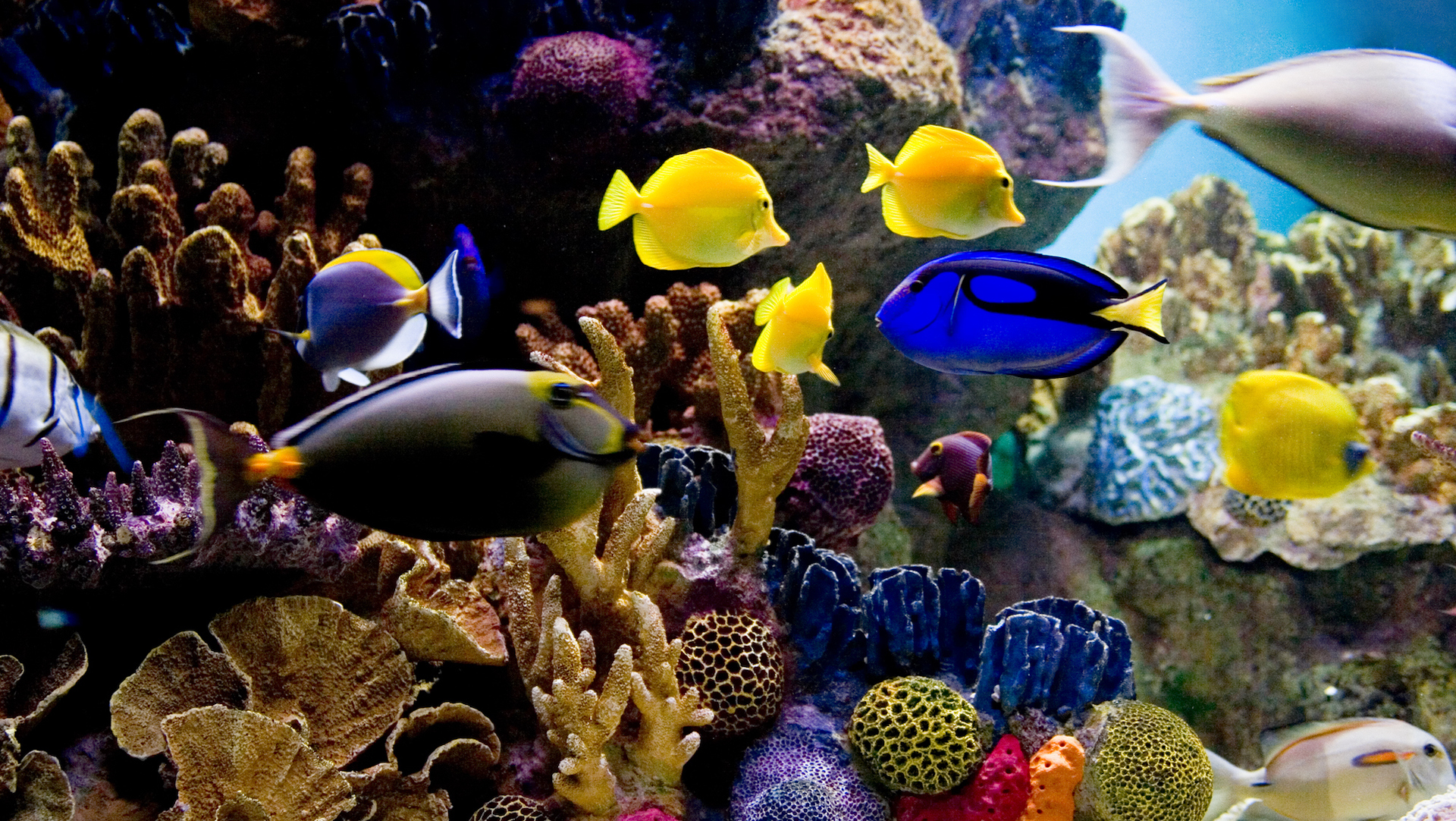
32 types of saltwater fish for your aquarium
A saltwater aquarium is an exotic and striking addition to the home. But more than a striking piece of furniture, it’s a living habitat that is both enthralling and engaging thanks to the vibrant creatures within.
Bear in mind that a saltwater aquarium is more expensive and difficult to set up and maintain than freshwater even if you chose one of the best fish tanks. Some of the fish, too, can fetch eye-watering prices. And with good reason, for a large proportion of them are vividly stunning, with a fantastic array of colors – which is due to the camouflage required in their natural habitat of the reef, where everything is bright and colorful.
Beginners need to choose their marine fish carefully, and it’s best to seek expert advice as regards factors such as compatibility of tank-mates, their temperaments, and the size of tank required. Some fish are naturally more hardy and resilient than others, and better suited to a novice aquarist.
Besides fish, you can add corals, anemones, starfish, shrimp, and other saltwater dwellers to mimic their natural oceanic environment. The world’s your oyster, so they say...
Let’s take a look at a range of types of saltwater aquarium fish, both common and rare, affordable and budget-busting.
1. Ocellaris clownfish
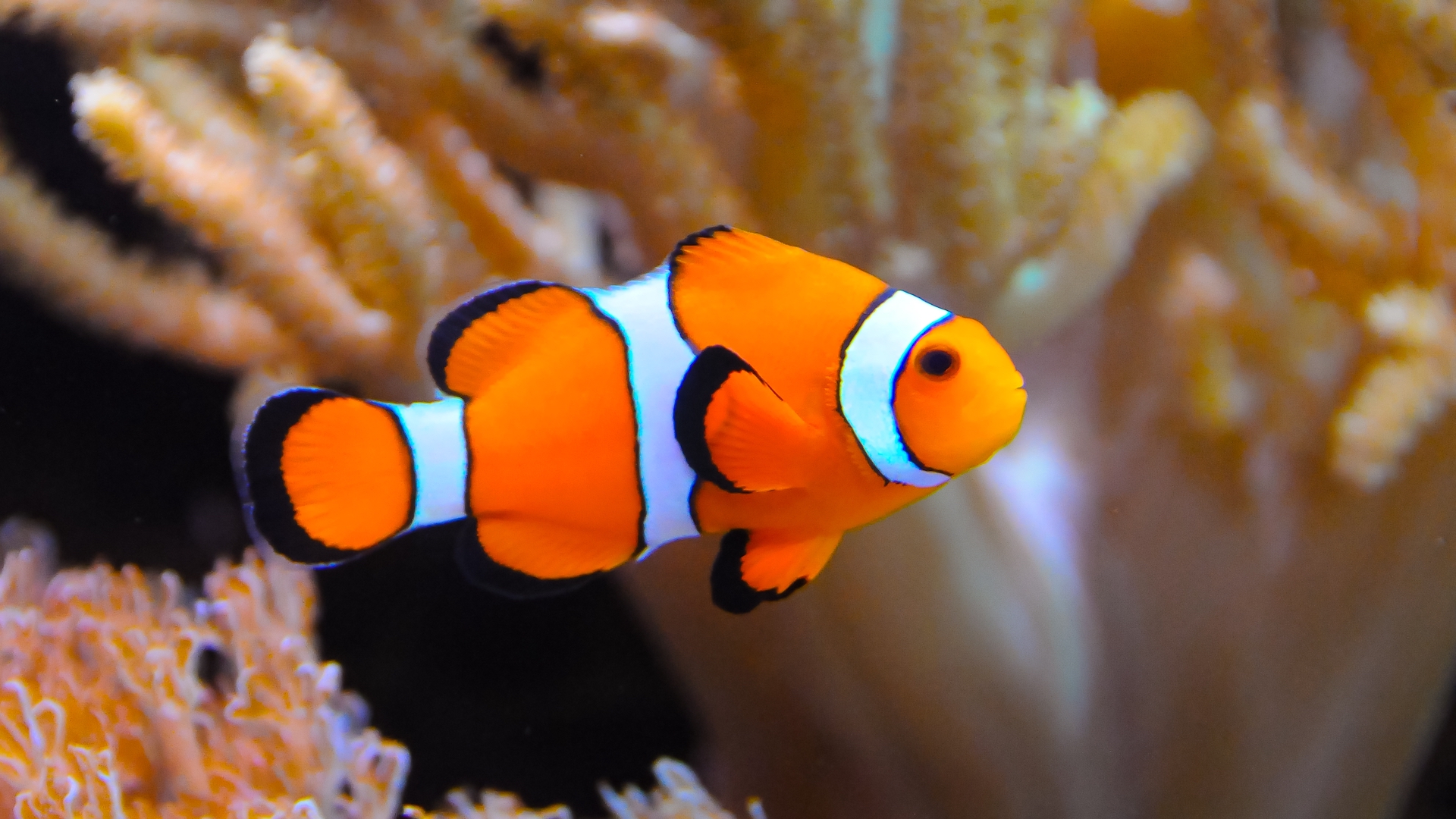
This classic saltwater aquarium fish – popularized by the movie Finding Nemo – is a hardy type and easy to keep. As they are territorial they don’t need a massive aquarium, though they do love an anemone, having a symbiotic relationship with them. Bear in mind that females can be quite aggressive.
Very similar to the true percula clownfish, with the differences being thinner black lines, 11 (rather than 10) dorsal spines, and darker eyes.
Get the best advice, tips and top tech for your beloved Pets
Also known as anemonefish, false percula clownfish and common clownfish; scientific name A. ocellaris.
Maximum length: 4.3 inches.
Wild habitat: Indian Ocean, Pacific Ocean, Great Barrier Reef, Southeast Asia, Japan and Indo-Malaysian region.
2. Yellow coral goby
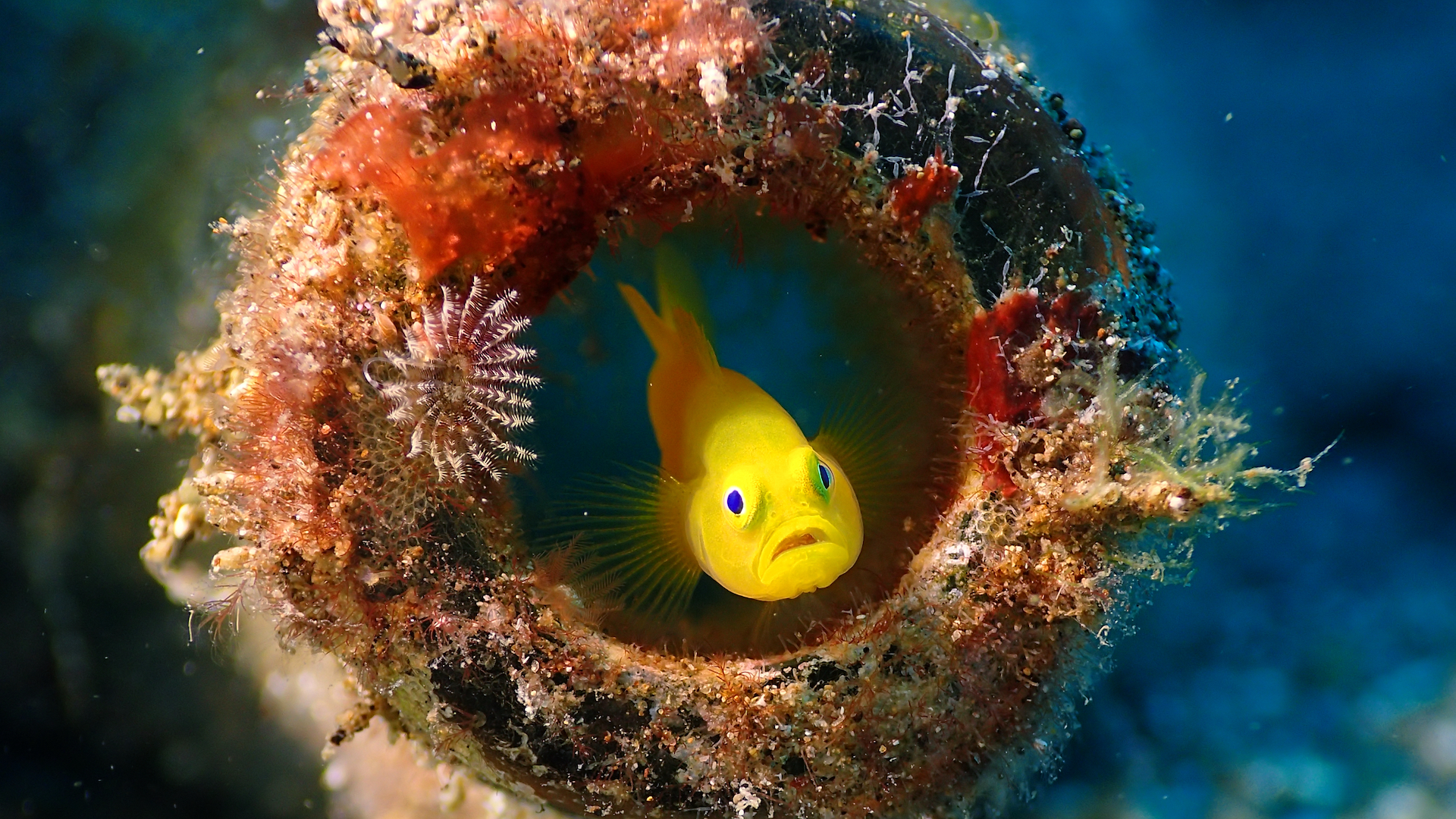
A peaceful little goby, without scales, which enjoys living in corals – their ventral fins form a unique suction cup that enables them to “sit” on the coral in strong currents. Their secret weapon is a toxic slime they secrete to ward off predators, but it doesn’t put off all their enemies so they should only be kept with small, non-aggressive tank-mates.
Also known as the yellow clown goby; the scientific name gobiodon okinawae.
Maximum length: 1.2 inches
Wild habitat: Indonesia and the Philippines.
3. Yellow watchman goby
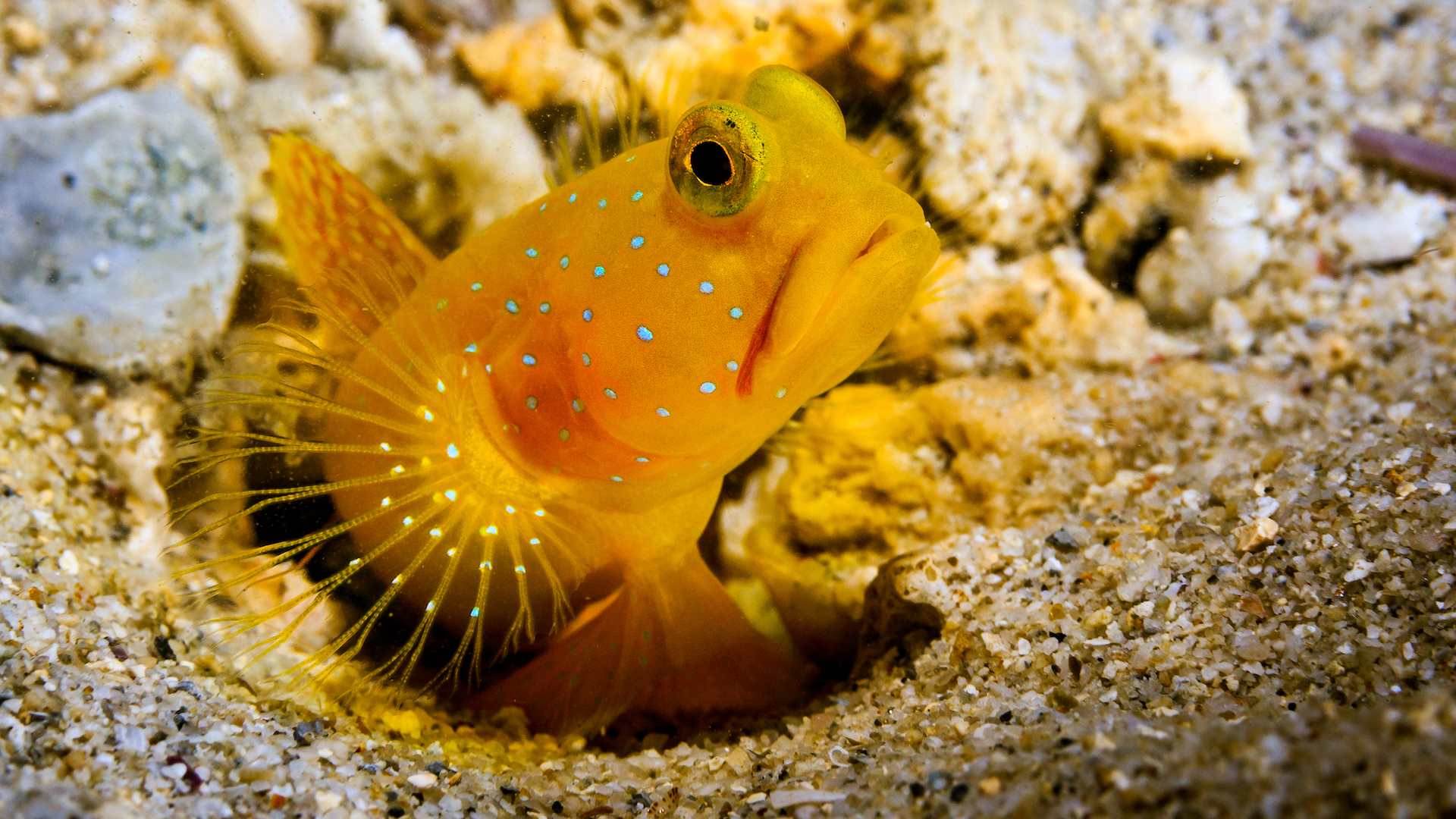
A rather grumpy-looking goby thanks to its downturned mouth, these fish enjoy burrowing in the sand at the bottom of the tank and can feed off the substrate as well as the water column.
They are territorial and can be aggressive. They should ideally be kept with pistol shrimp.
Also known as the sulphur goby and yellow prawn goby; the scientific name cryptocentrus cinctus.
Maximum length: 4 inches
Wild habitat: Western Pacific.
4. Yellowtail damselfish
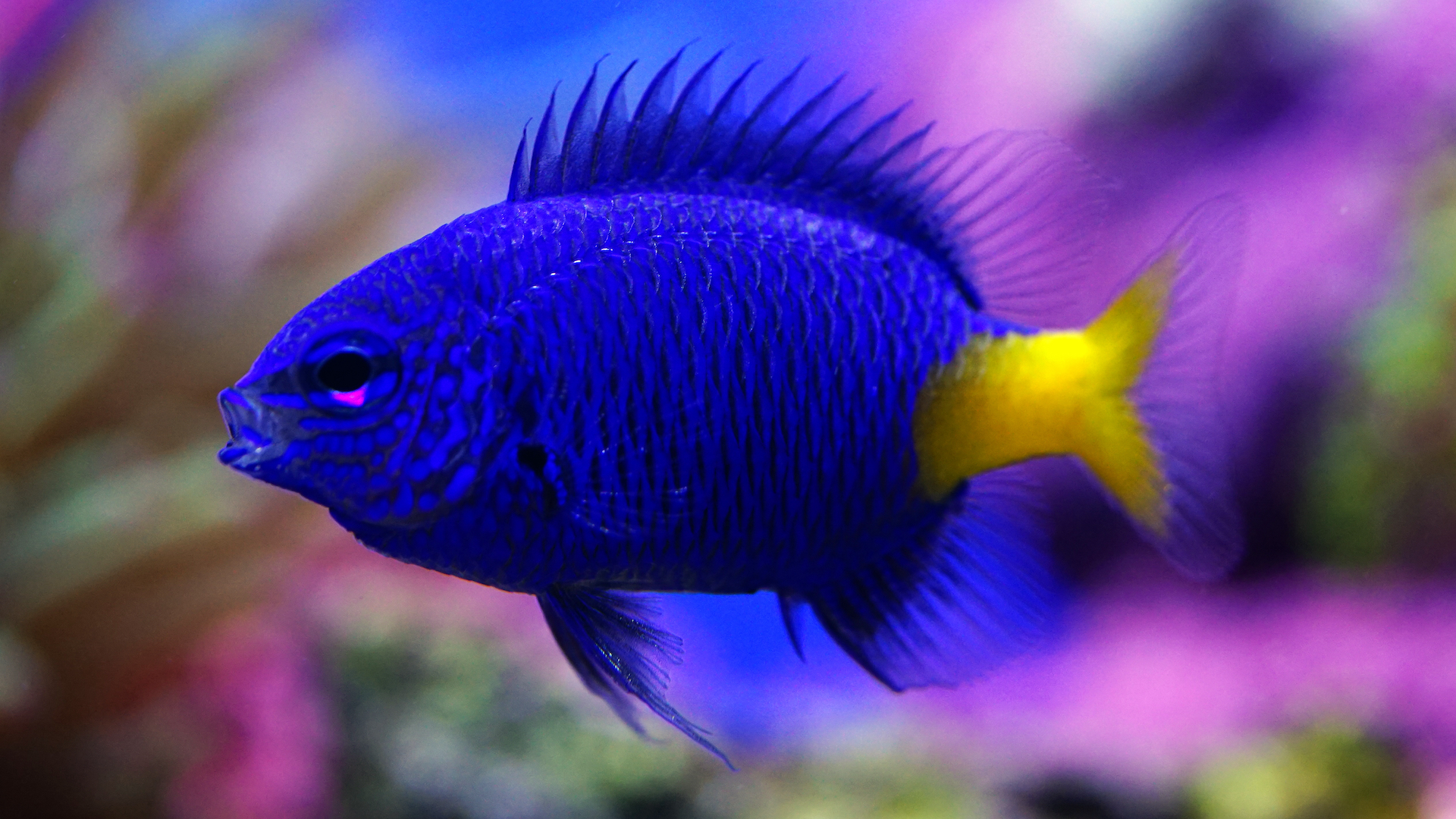
A peaceful and hardy fish with stunningly vibrant looks. Some damsels can be aggressive but not this one – though it does require multiple hiding places and fellow chilled-out tankmates.
Also known as the yellowtail demoiselle; the scientific name chrysiptera parasema.
Maximum length: 2 inches
Wild habitat: Indonesia.
5. Pyjama cardinal
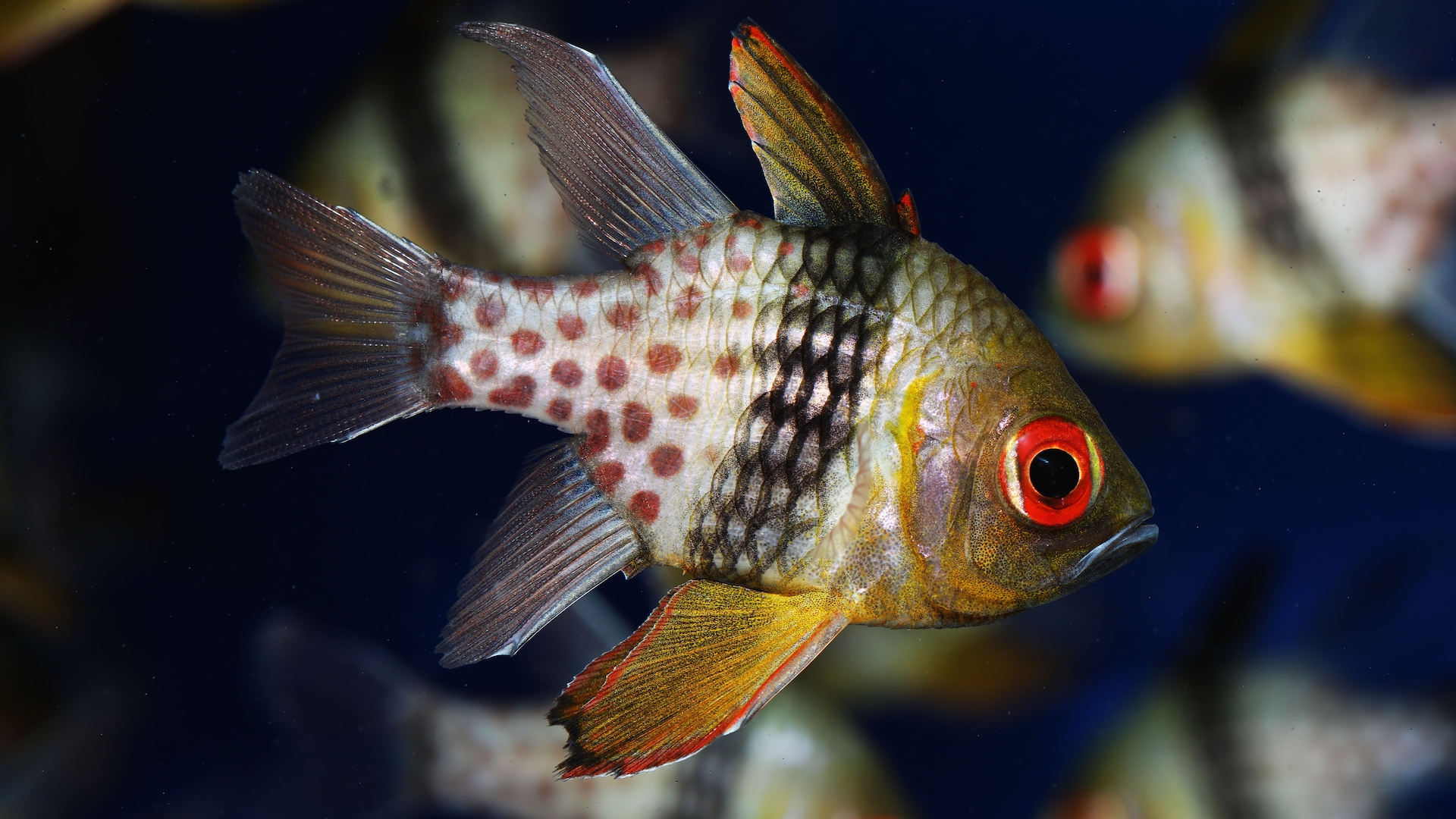
A shy but hardy fish that needs to be kept in a group of at least three, without aggressive tankmates, and requires adequate hiding places. As cute as its name implies, dressed in spotty, stripy pajamas.
Also known as the spotted cardinalfish; scientific name sphaeramia nematoptera.
Maximum length: 3.5 inches
Wild habitat: Indonesia
6. Blue/green reef chromis
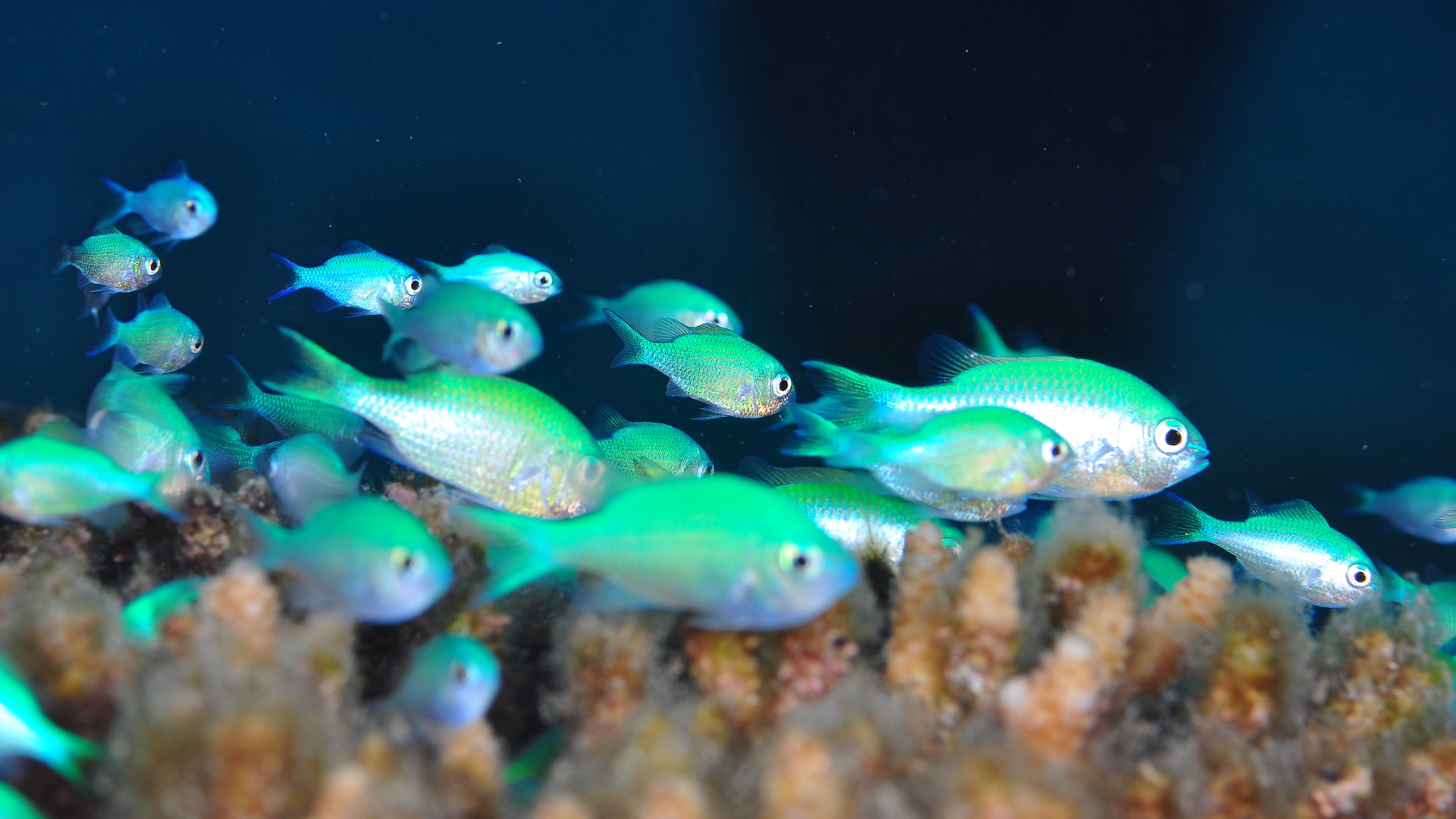
These delightful flashes of turquoise typically live in shoals (one male to five females) though they can pick on each other, especially dominant males. They require plenty of hiding spots, such as coral.
Scientific name chromis viridis.
Maximum length: 3.1 inches
Wild habitat: East Indian Ocean, West Indian Ocean, Australia, Japan, Red Sea, Indonesia, East Pacific, Central/West Pacific.
7. Firefish goby
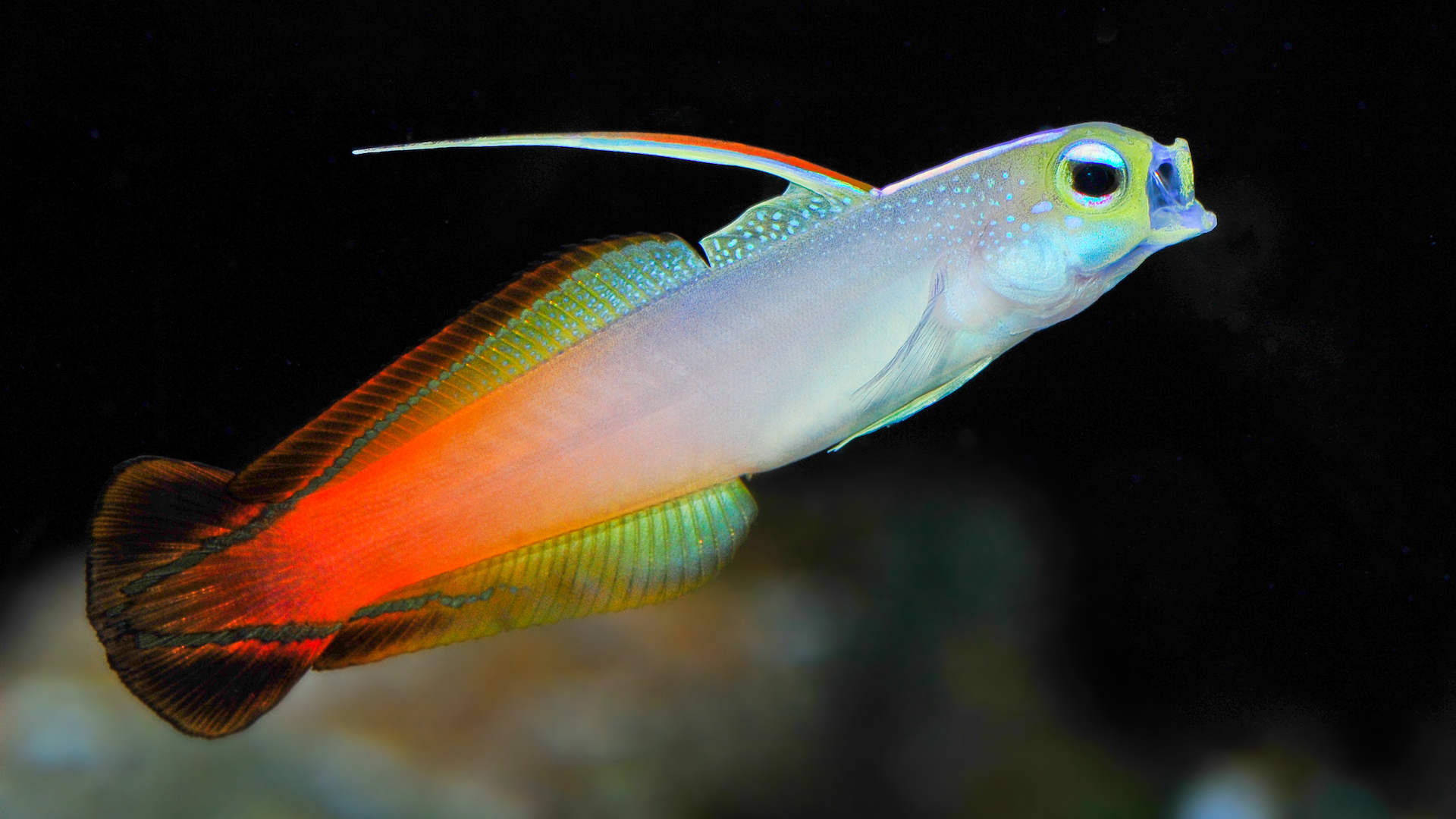
These torpedo-shaped dartfish may look flashy but they are peaceful and easily feel threatened by larger, more aggressive fish, needing suitable places to hide. Their characteristic behavior is to dart around and suddenly dive for cover.
Also known as fire dartfish and fire goby; scientific name nemateleotris magnifica.
Maximum length: 3.5 inches
Wild habitat: East Indian Ocean, West Indian Ocean, Indonesia, East Pacific, Central/West Pacific.
8. Longnose hawkfish
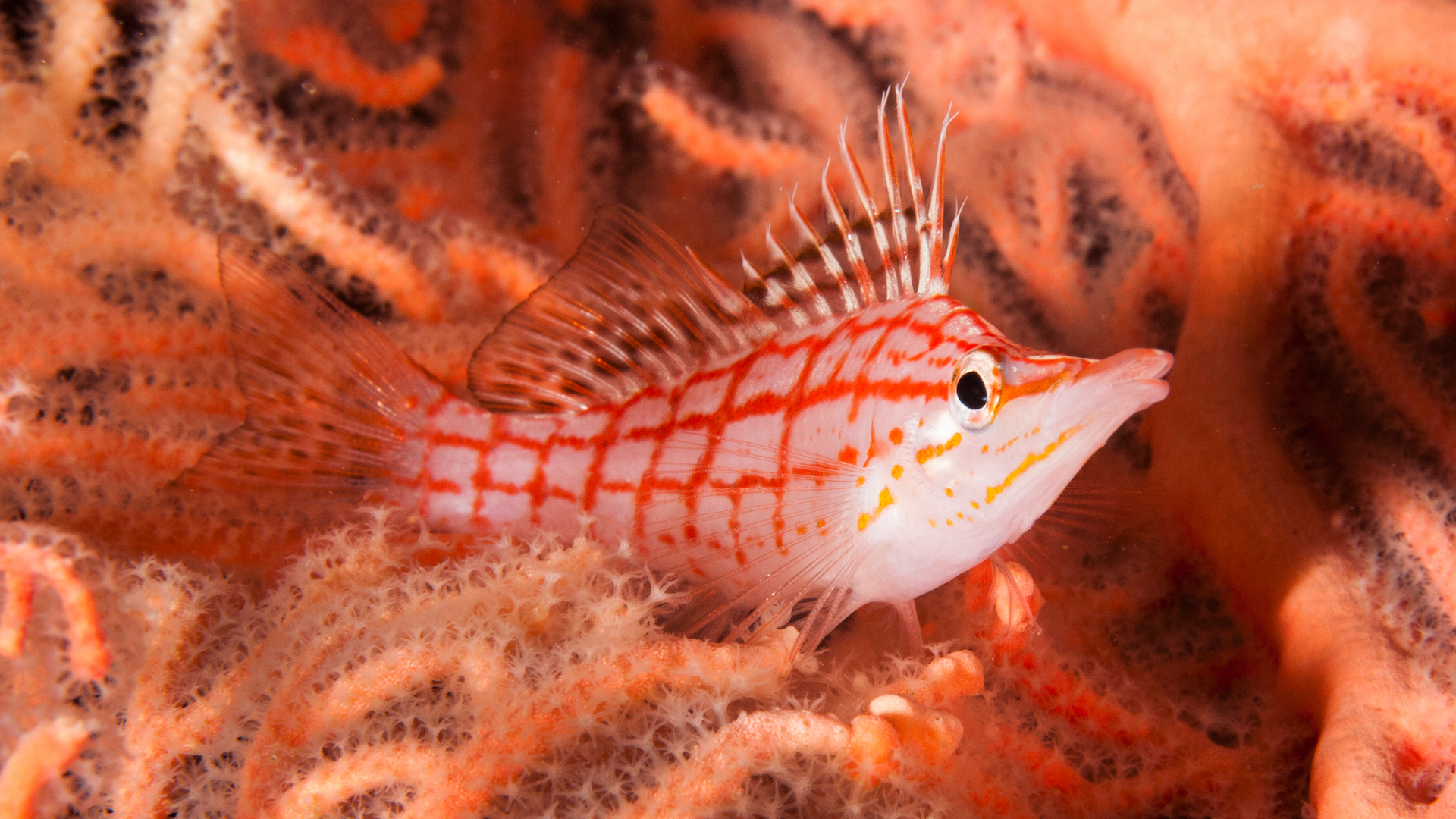
A funky-looking marine fish, with its ray fins and pointy nose. It will eat anything it can fit into its mouth – and has the mildly terrifying ability to smash larger prey on rocks to make it bite-size. Consequently, they can be threatening, especially to crabs, shrimps, and smaller fish, and are known for hopping out of tanks, so make sure yours is covered.
Scientific name oxycirrhites typus.
Maximum length: 5.1 inches
Wild habitat: East Indian Ocean, West Indian Ocean, Red Sea, Mexican Gulf, West Atlantic.
9. Bicolor blenny
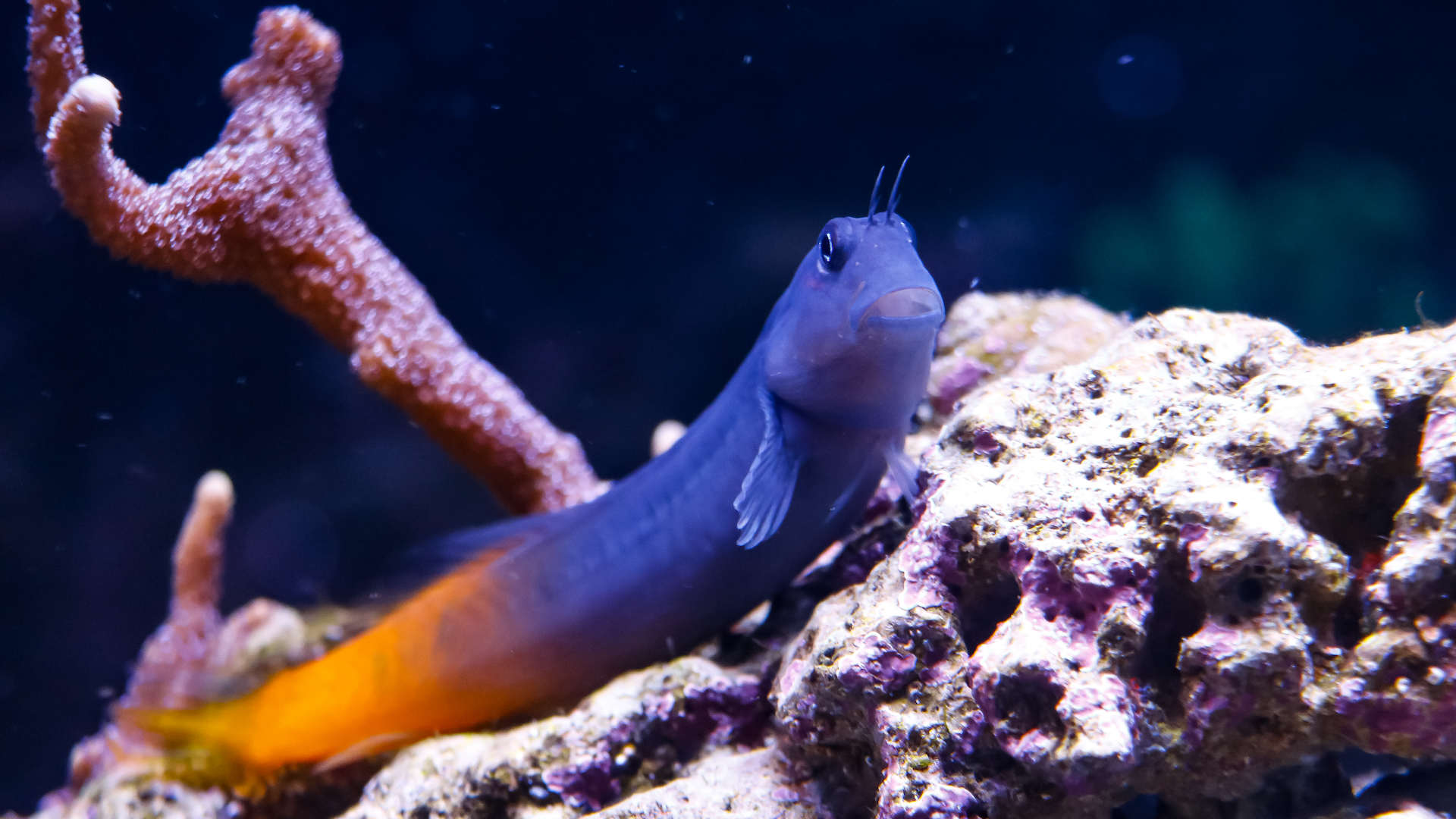
Bicolor blennies are easy to look after and thrive on their own. They have a fun appearance, looking like they are wearing a different top and trousers. They are grazers, who enjoy nibbling on algae from rocks and stones.
Scientific name ecsenius bicolor.
Maximum length: 4.3 inches
Wild habitat: Indo-Pacific: Maldives to the Phoenix Islands, north to the Ryukyu Islands, south to the southern Great Barrier Reef; throughout Micronesia.
10. Lawnmower blenny
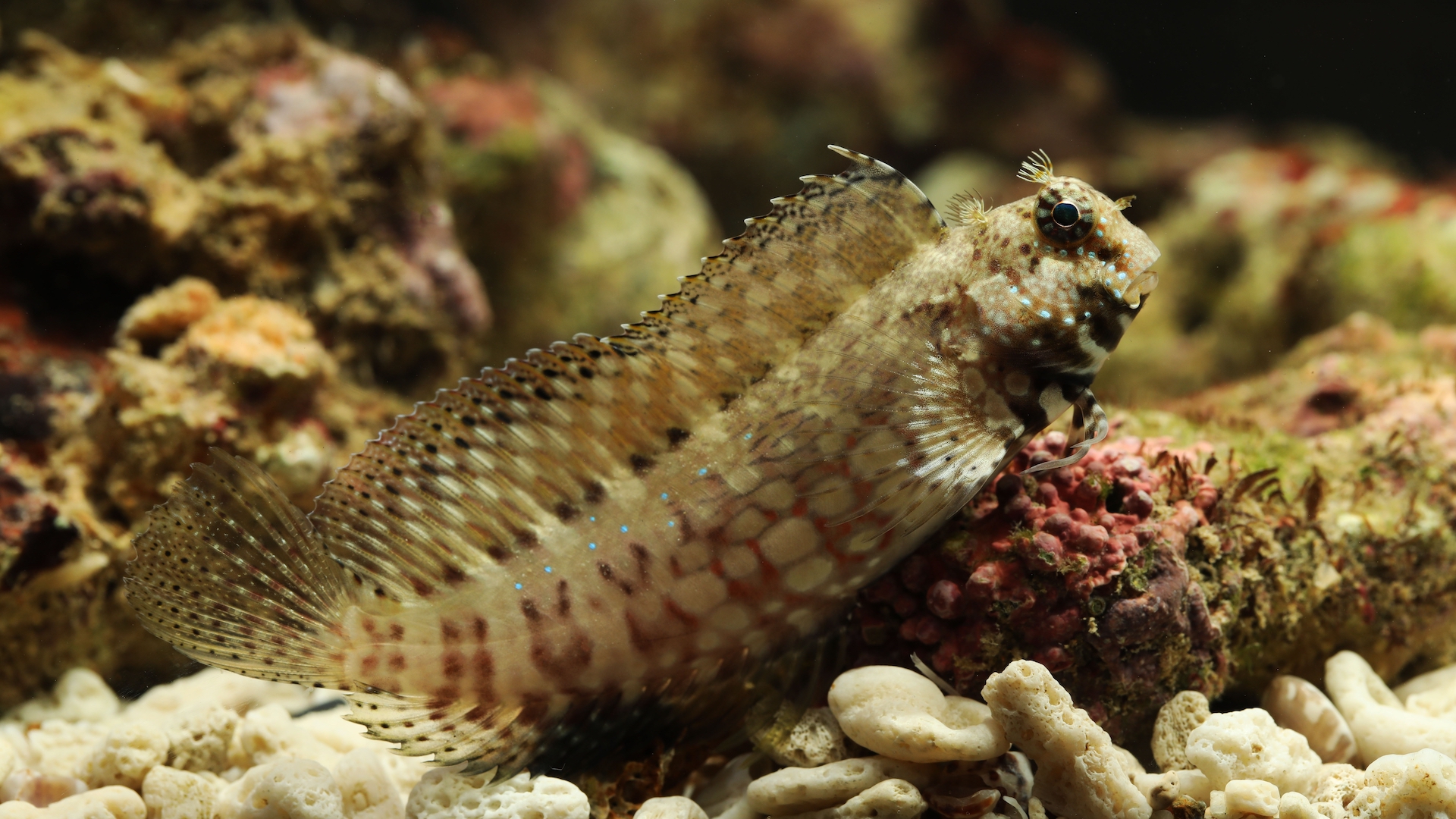
If you struggle to control the algae in your tank, the appealingly named lawnmower blenny is the one to keep your aquarium as clean and tidy as a croquet lawn. They eat large amounts of algae from rocks, especially filamentous and green-haired algae.
These mottled fish with captivating big eyes don’t love their own kind, however, often being very aggressive to other blennies.
Also known as jeweled blenny and algae blenny; scientific name salarius fasciatus.
Maximum length: 5.5 inches
Wild habitat: East Indian Ocean, West Indian Ocean, Australia, Japan, The Red Sea, Indonesia, East Pacific, Central/West Pacific.
11. Royal gramma
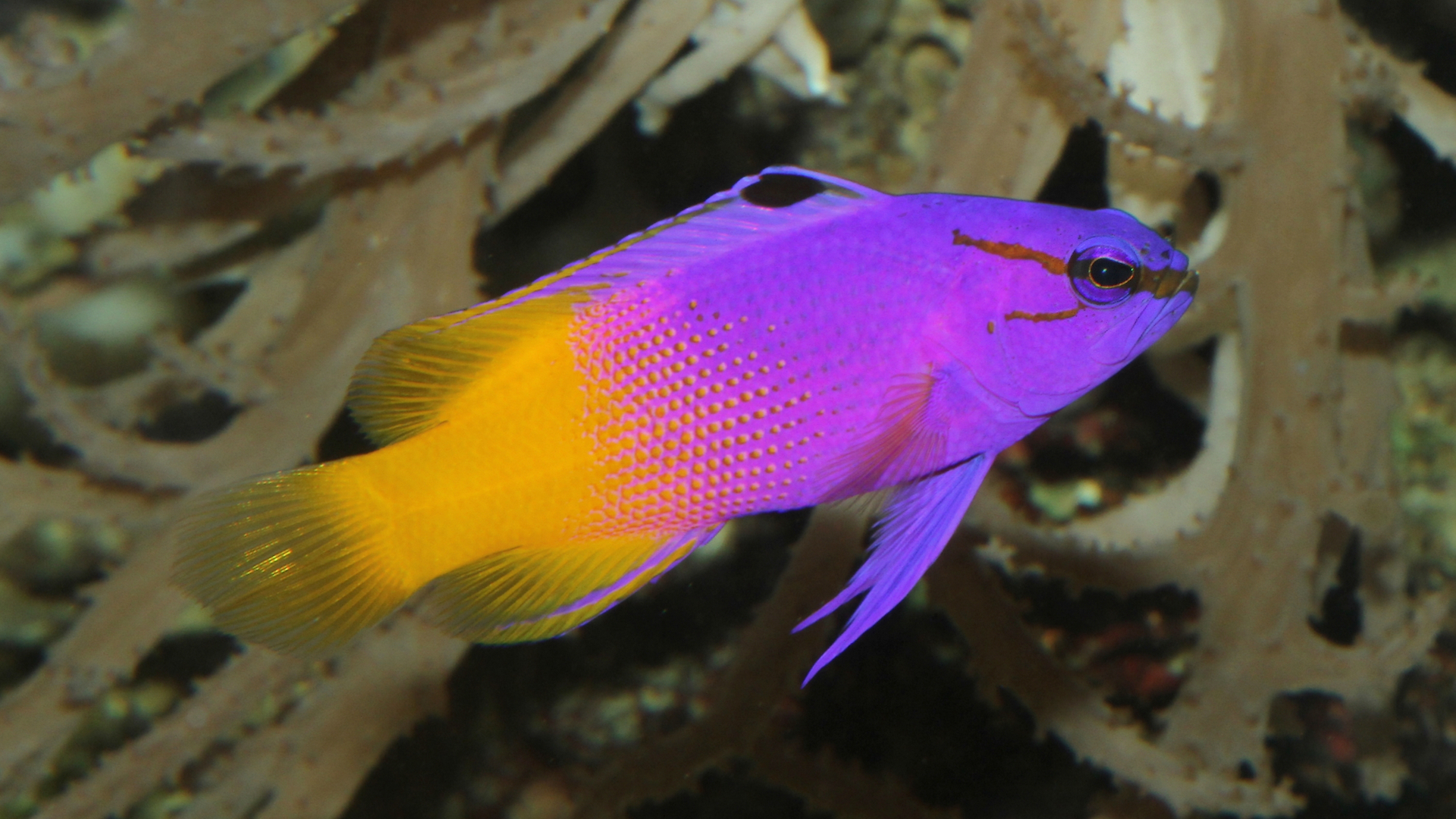
Despite its vivid, “look-at-me” appearance, the two-tone royal gramma is a peaceful, gentle fish with a tendency to hide away. However, they can fight with their own kind and gender, so do well kept solo. And beware, this is a fish that loves to jump!
Also known as fairy basslet; scientific name gramma loreto.
Maximum length: 3.9 inches
Wild habitat: Mexican Gulf, West Atlantic
12. Coral beauty angelfish
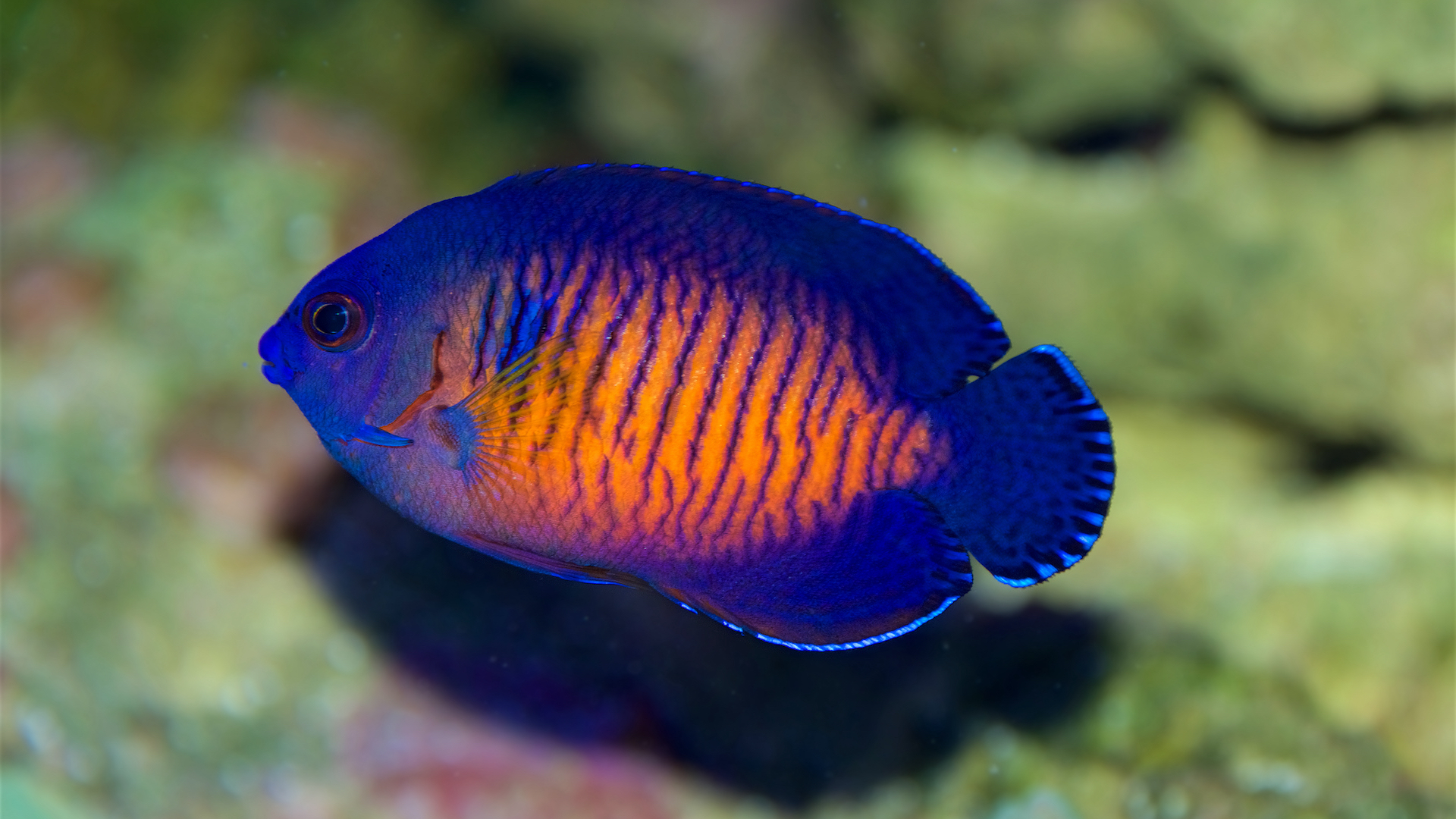
A dwarf angelfish boasting an impressive color palette, with royal blue heads and fins framing their iridescent orangey-yellow body pattern. Visually stunning, easy to care for, and a mesmerizing spectacle, these are a favorite with both beginner and expert aquarists.
Also known as the two-spined angel and dusky angelfish; scientific name centropyge bispinosa.
Maximum length: 3.9 inches
Wild habitat: East Indian Ocean, West Indian Ocean, Australia, Japan, Indonesia, East Pacific, Central/West Pacific.
13. Six line wrasse

A stunning stripy fish, their bold looks match their aggressive tendencies. They can be threatening to other fish, including their own species. Handy in ridding your tank of flatworm and pyramid snails, which they are known to feed on. They sleep in nooks with a protective mucus coat to put predators off their scent. Another nifty skill is their ability to jump clean out of your tank. Lively, distinctive, and fun, and an expert in pest control.
Also known as pyjama wrasse; scientific name psuedocheilinus hexataenia.
Maximum length: 3.1 inches
Wild habitat: East Indian Ocean, West Indian Ocean, Australia, Red Sea, Indonesia, East Pacific, Central/West Pacific.
14. Rusty angelfish
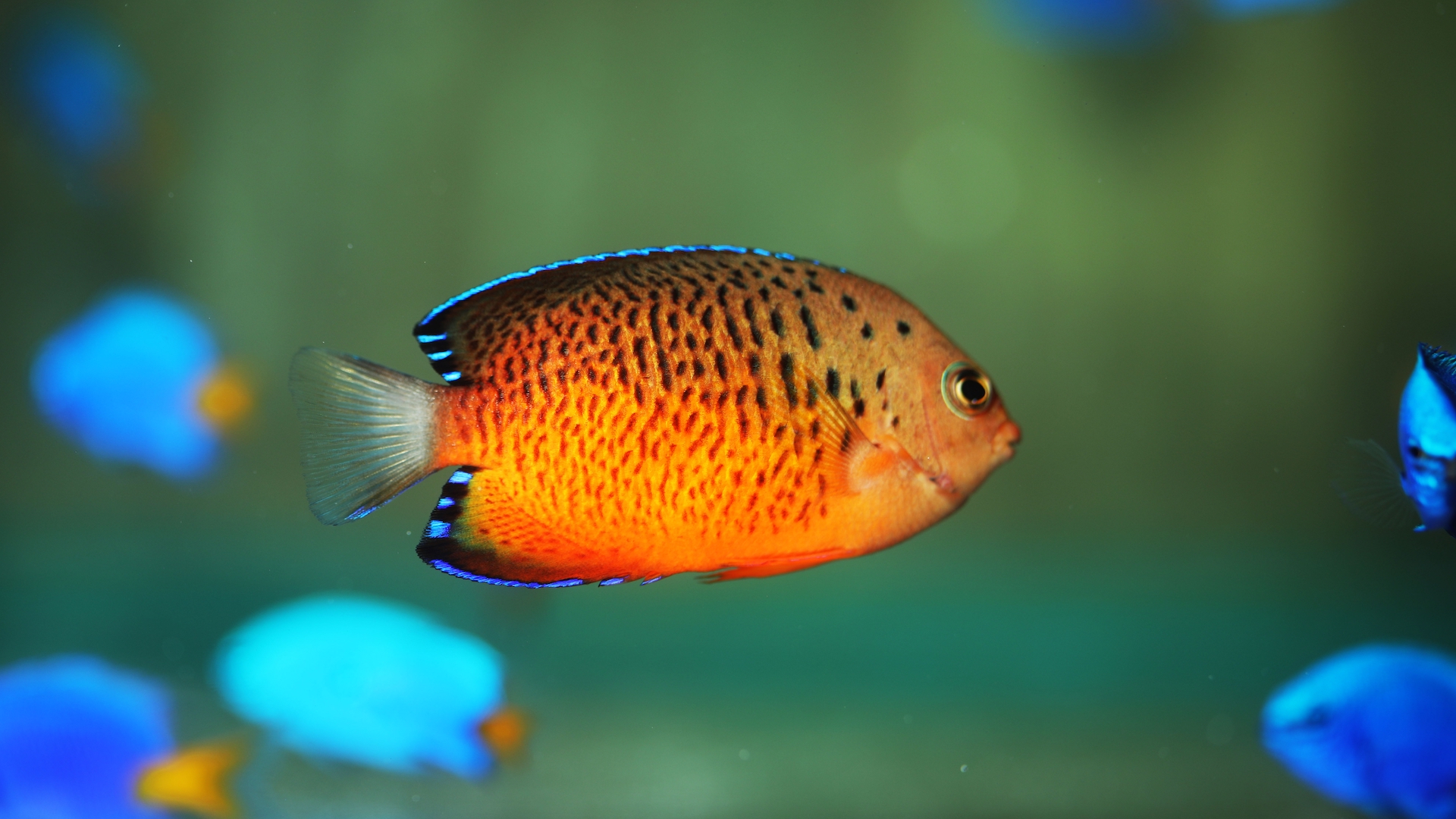
A dwarf angelfish that is best kept as the only one of its kind in the tank. Their rusty orange body is punctuated with black bars and vibrant blue accents on its fins. A fan of algae, they also like to nip at corals and are constantly on the move.
Scientific name centropyge ferrugata.
Maximum length 3.9 inches
Wild habitat: Australia, Japan, Indonesia.
15. Flashback Dottyback
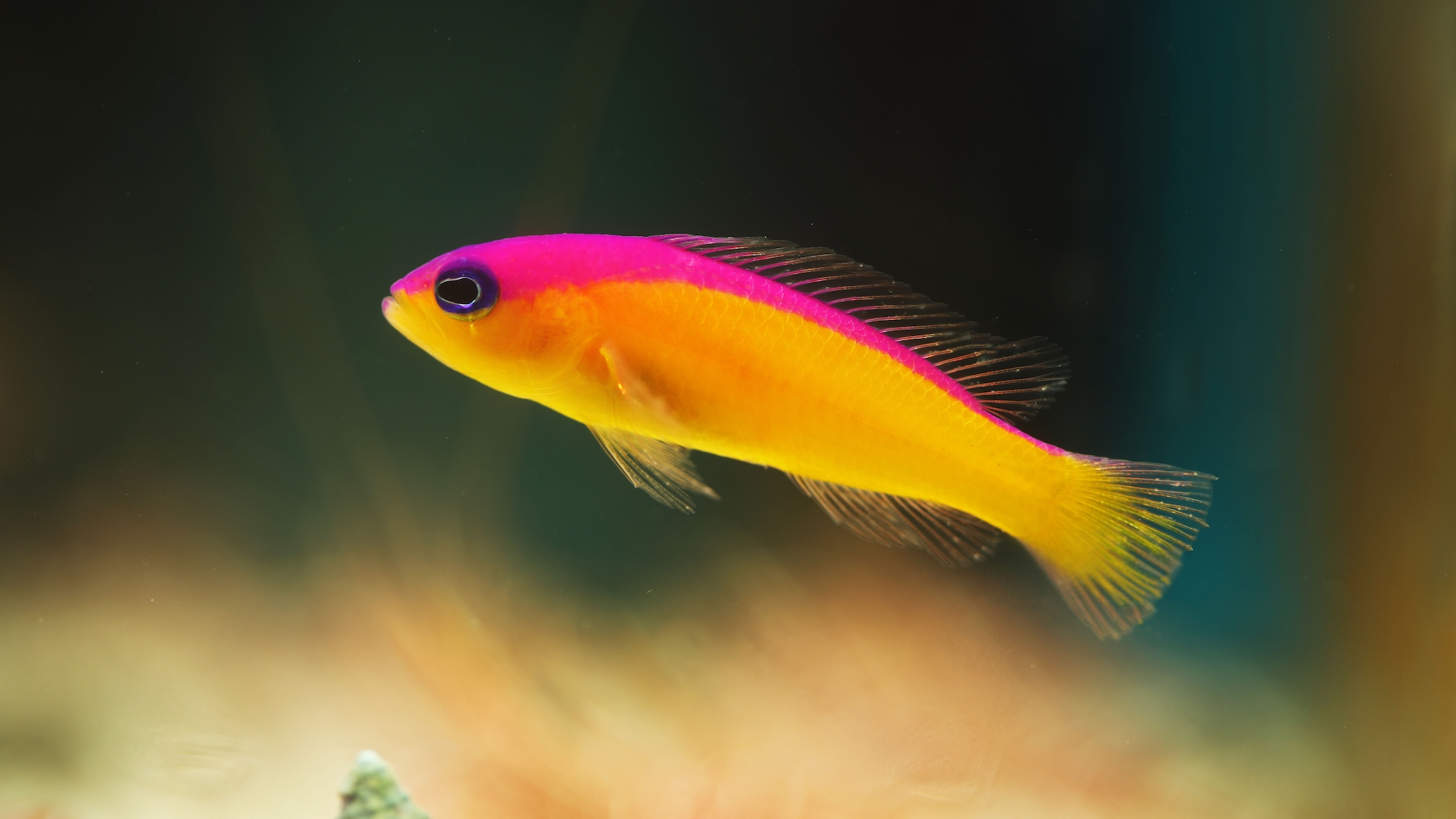
Stunning, but highly territorial. If you want a gentler version of the psychedelic colors, then the more docile royal gramma would be a better fit. This is a very energetic and aggressive little number, adept at jumping out of its tank and fierce in the face of newcomers. Tank mates need to be robust and provided with plenty of spots to hide away from the marauding dotty back.
Also known as diadem dottyback; scientific name pictichromis diadema.
Maximum length: 2.4 inches
Wild habitat: Indonesia, Central/West Pacific.
16. Yellow Wrasse
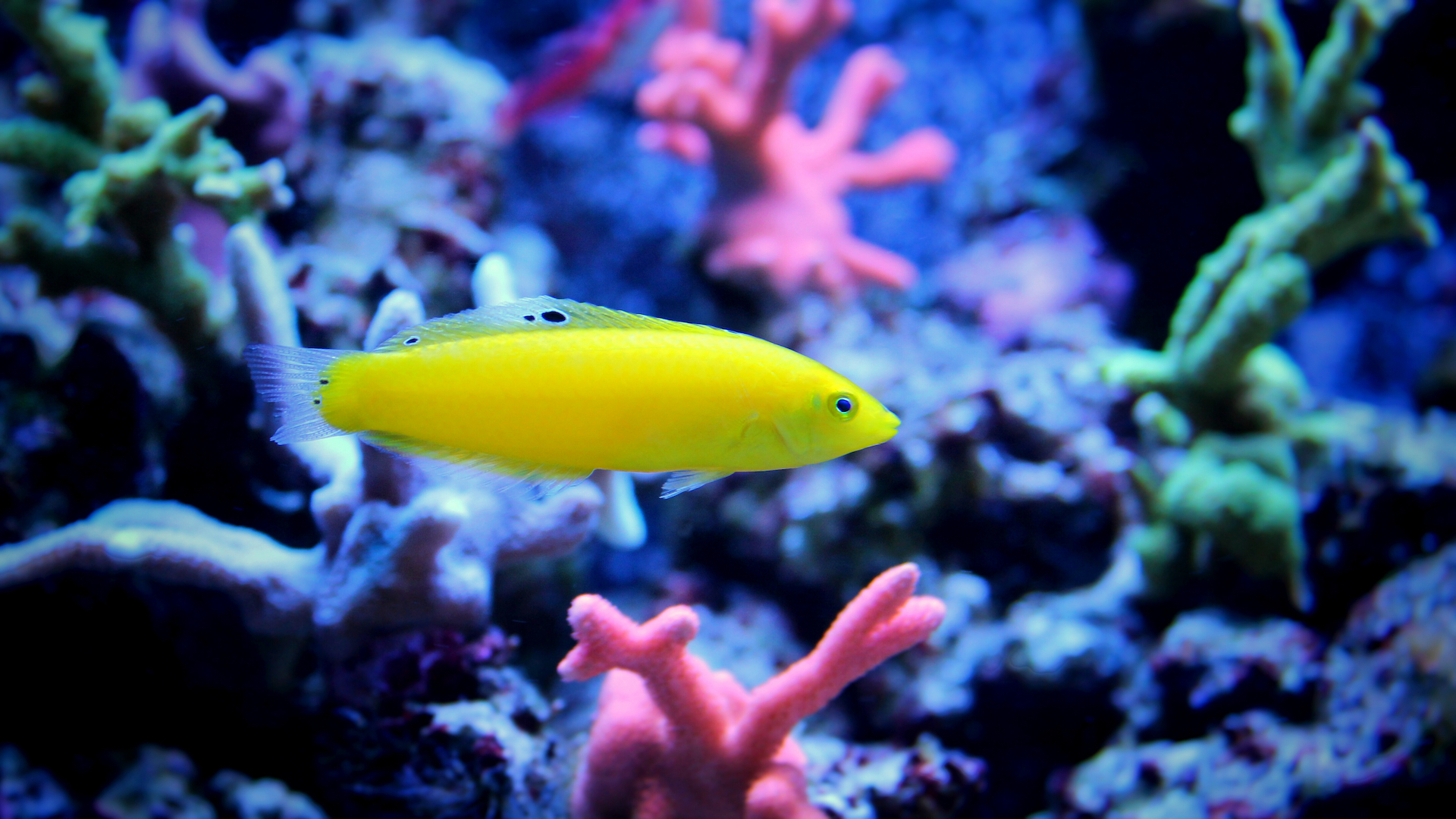
Brightly colored and affordable, the yellow wrasse is a useful fish as it combats pyramid snails and flatworms. While they are active swimmers, they do require a deep sandy bed to burrow into, either when scared or to sleep. They are peaceful and can live alongside other species of marine fish, including other wrasses.
Also known as golden wrasse, golden rainbowfish, and canary wrasse; scientific name halichoeres chrysus.
Maximum length: 5.5 inches
Wild habitat: Australia, Indonesia.
17. Chalk Bass
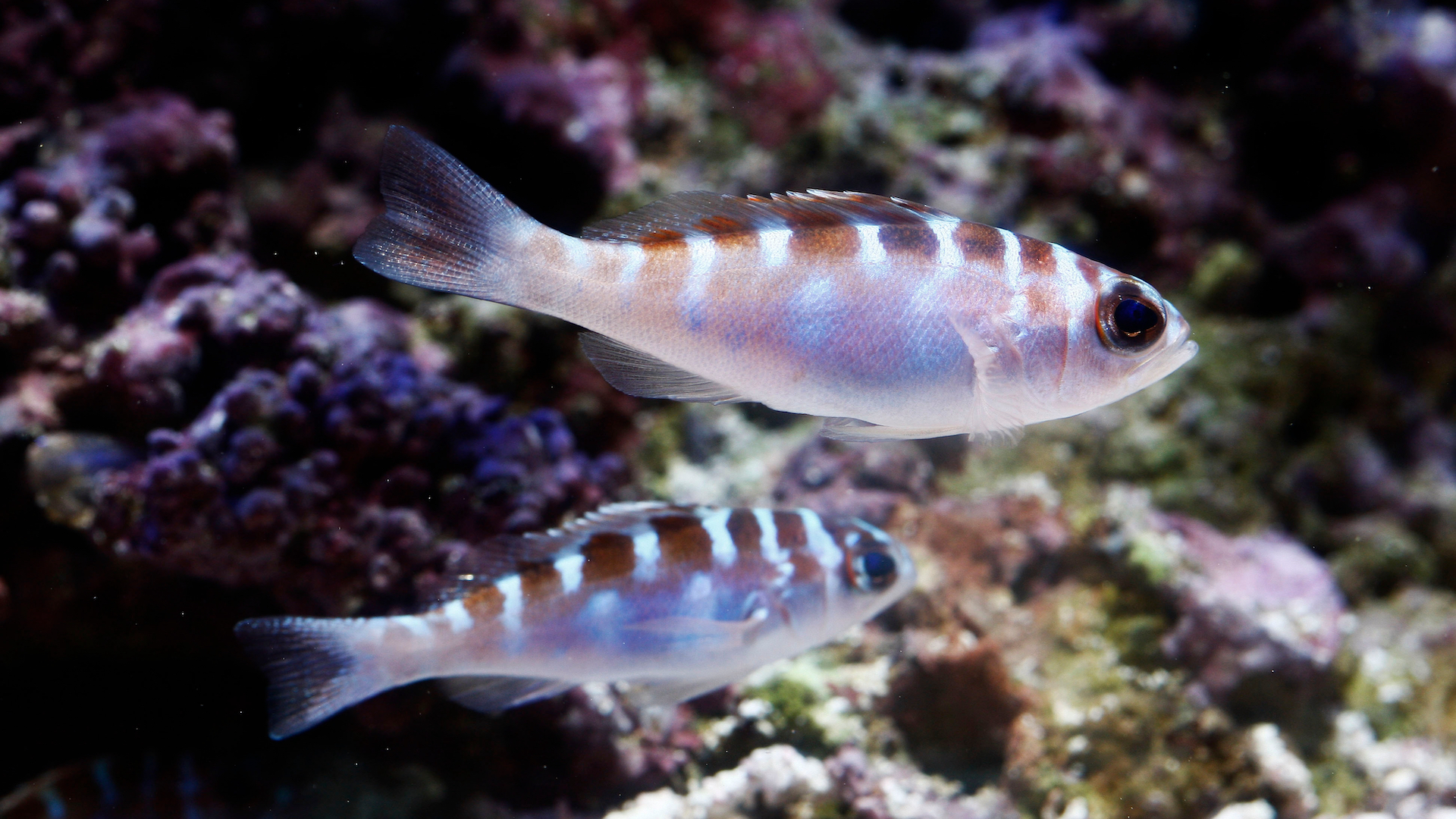
These little charmers with their orange bodies and electric blue stripes (in varying degrees of color) tend to be on the skittish side, especially when settling into a tank, so need plenty of hiding places.
Also known as Caribbean blue bass; scientific name serranus tortugarum.
Maximum length: 3.1 inches
Wild habitat: Mexican Gulf, West Atlantic.
18. Bicolor Angelfish
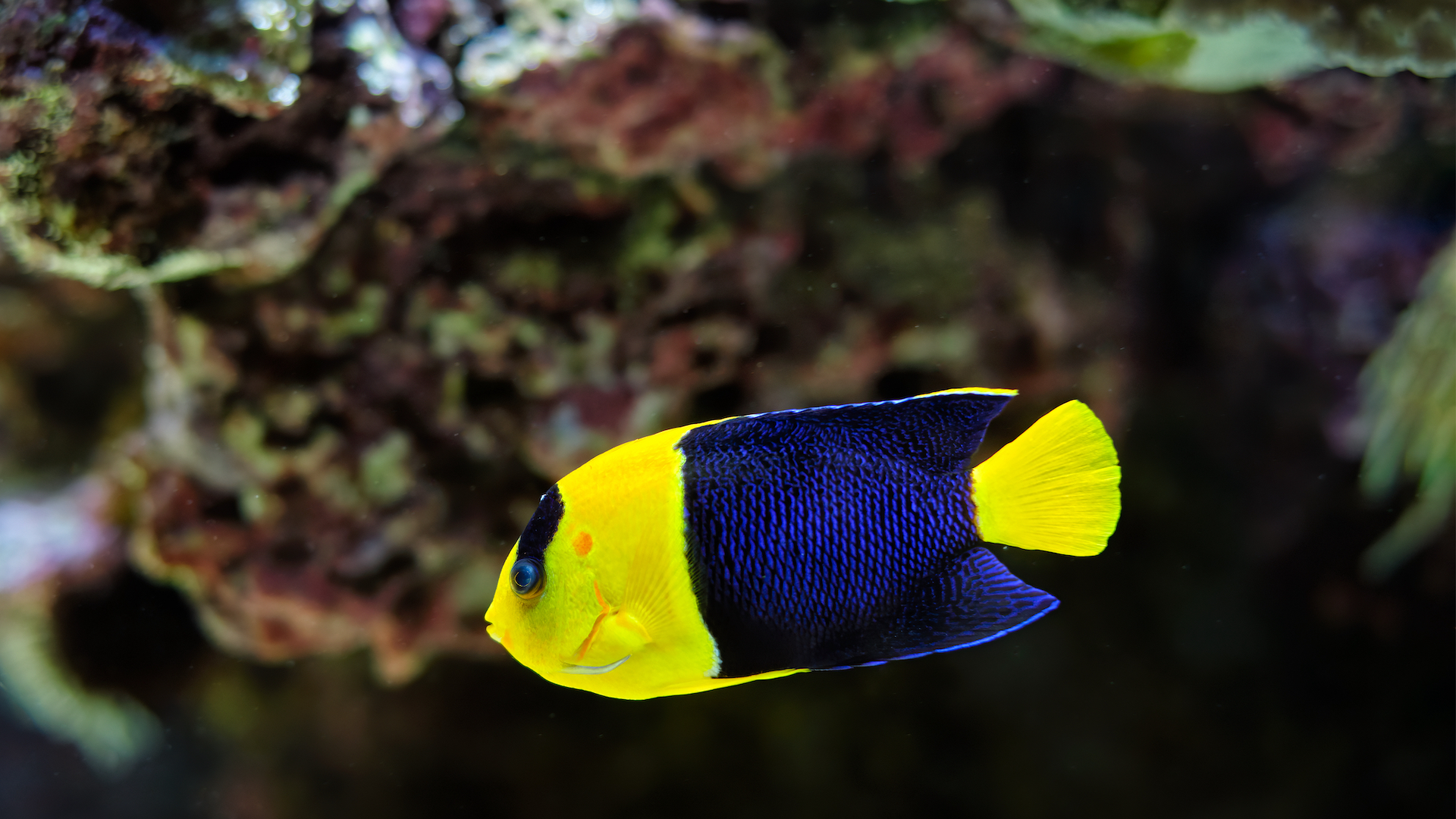
With their bold contrasting colors, these dwarf angelfish are a striking addition to your marine tank – though they thrive best as the only species. They are moderately aggressive, with territorial males guarding their harem.
Also known as Pacific rock beauty, oriole angelfish, blue and gold angel; scientific name centropyge bicolor.
Maximum length: 3.1 inches
Wild habitat: East Indian Ocean, West Indian Ocean, Australia, Indonesia.
19. Diamond watchman goby
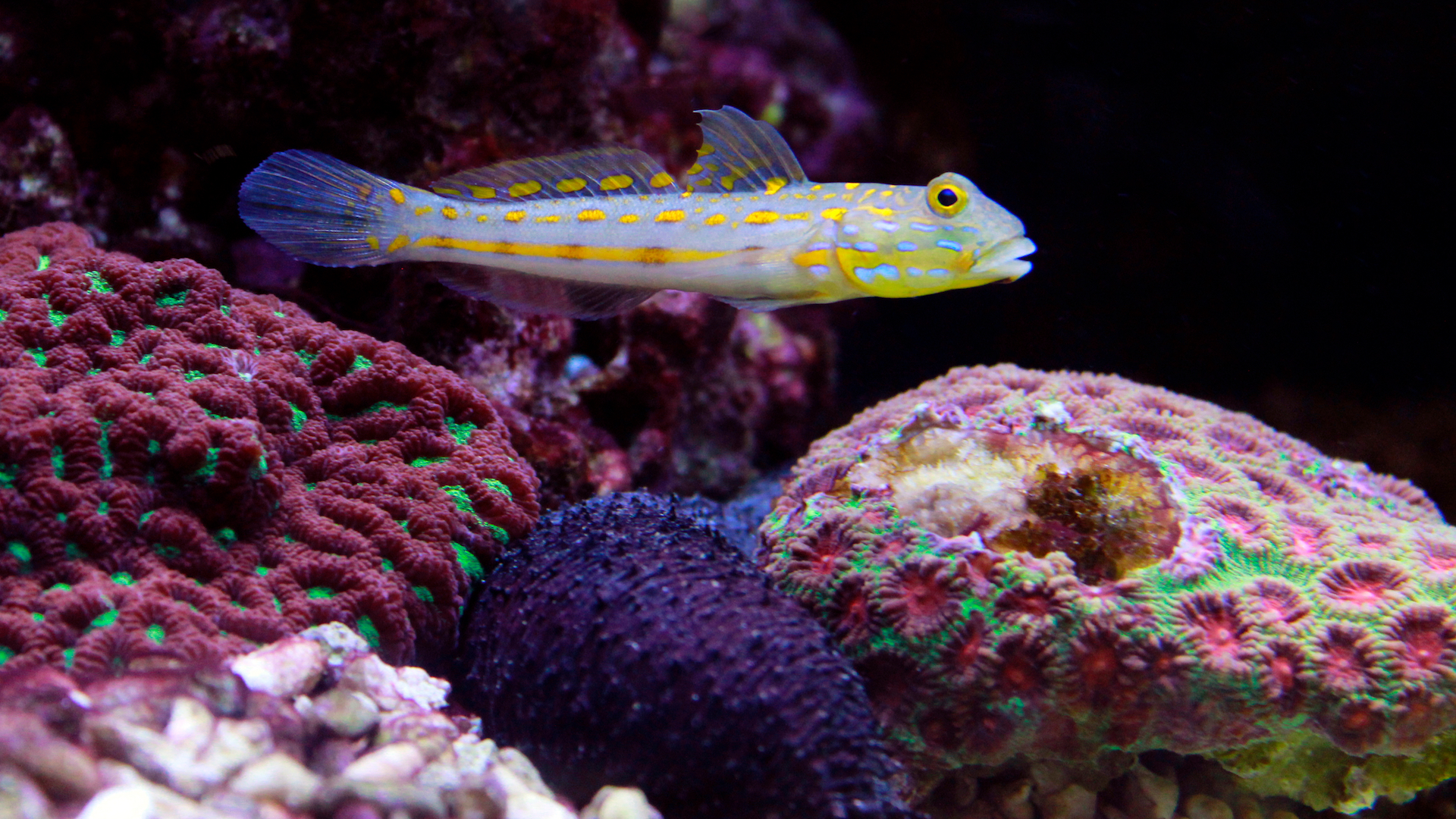
A glimmering silver goby, dashed and dotted with blue and orange, whose number one task is to keep your sand bed sparkling clean. They filter the sand through their gills for the food it contains. A companionable fish, these gobies thrive in a male/female pair.
Also known as orange-dashed goby, orange spotted glider goby; scientific name valenciennea puellaris.
Maximum length: 6.7 inches
Wild habitat: East Indian Ocean, West Indian Ocean, Australia, Indonesia, East Pacific, Central/West Pacific.
20. Threadfin butterflyfish
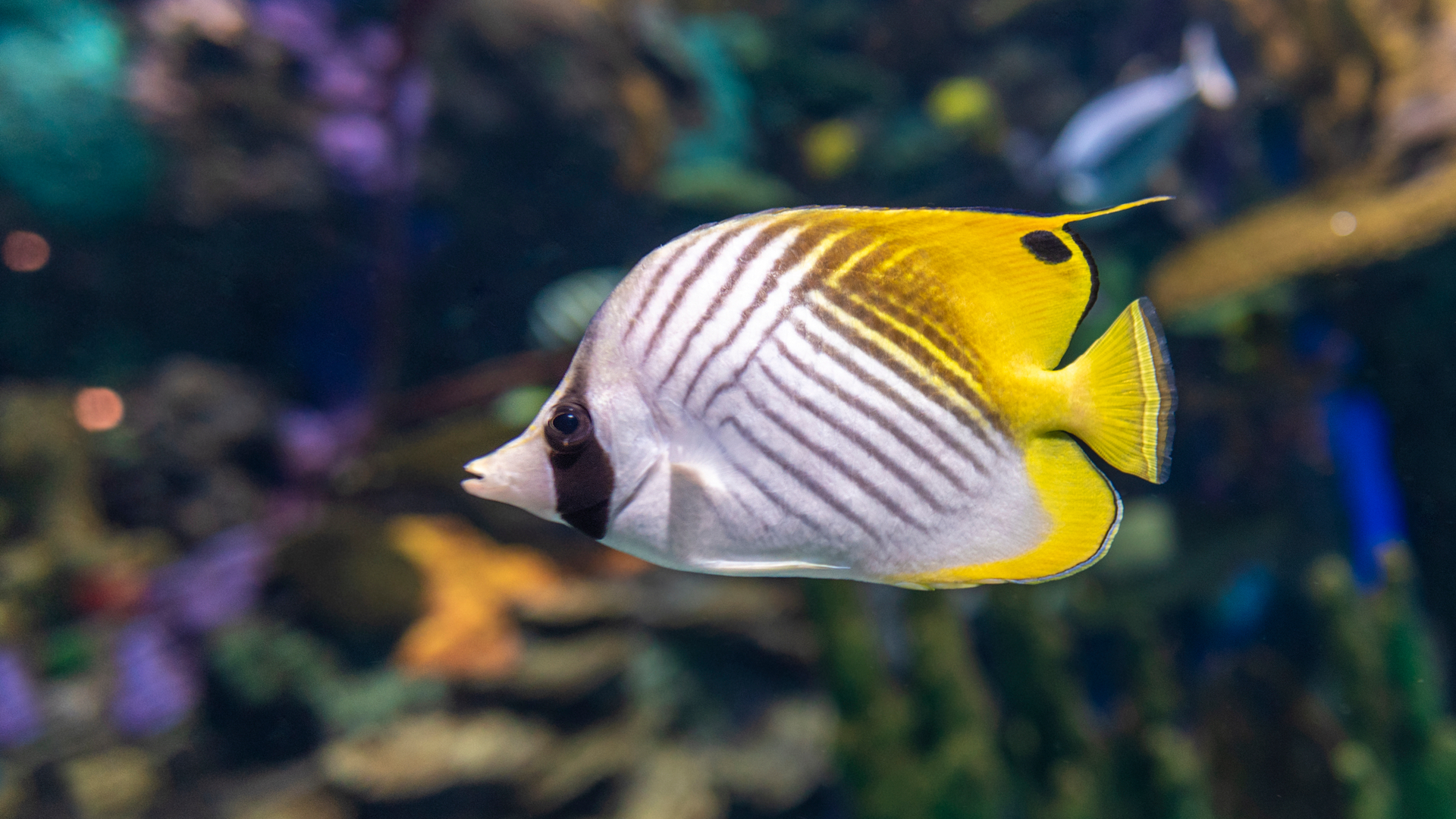
A keen swimmer, this vibrant fish with striking markings is a peaceful tank mate that tends to coexist harmoniously with other species.
Also known as threadfin coralfish, cross-stripe butterfly; scientific name chaetodon auriga.
Maximum length: 9.1 inches
Wild habitat: East Indian Ocean, West Indian Ocean, Australia, Japan, Red Sea, Indonesia, East Pacific, Central/West Pacific.
21. True percula clownfish
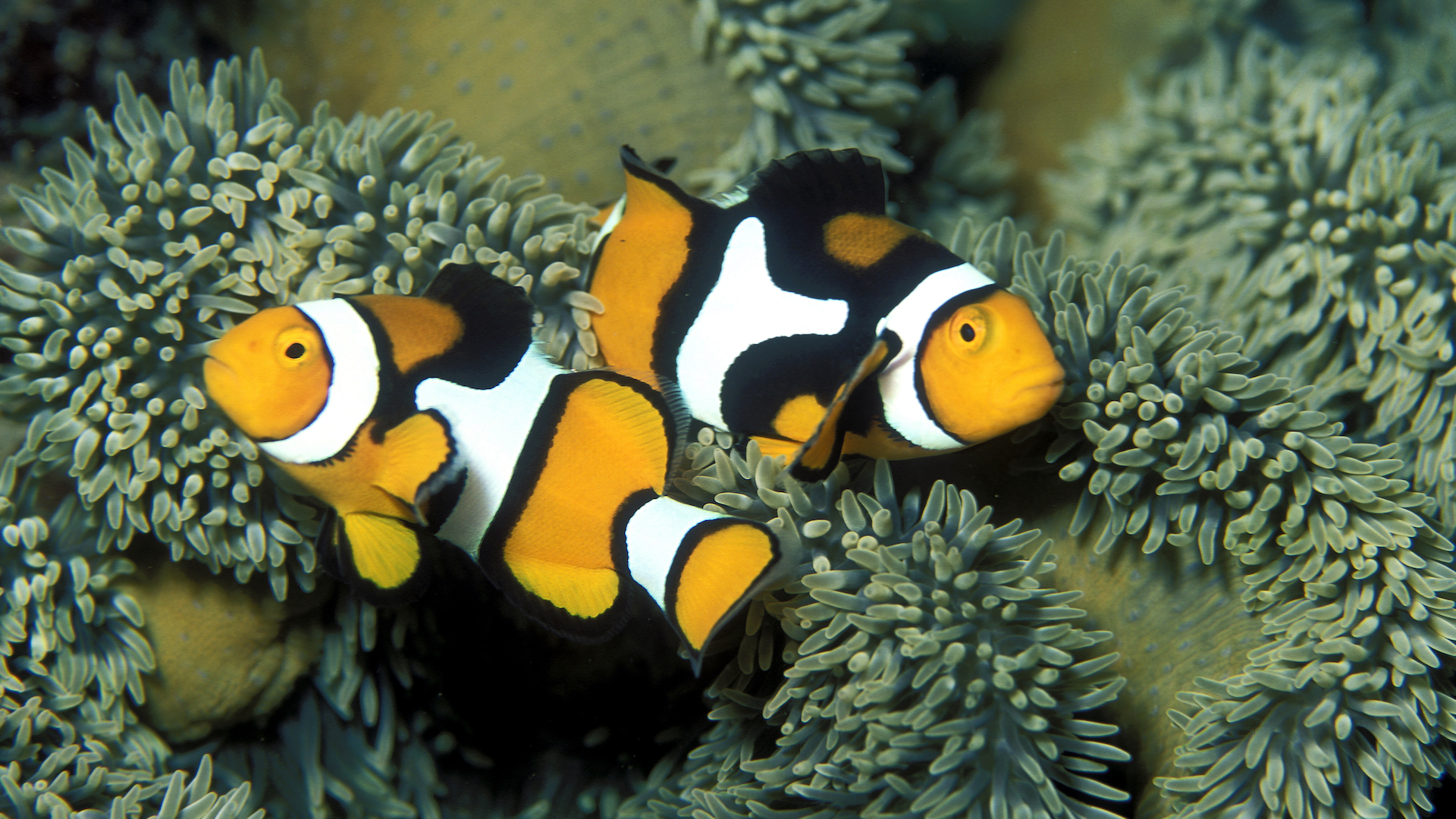
These popular fish like to live in male/female pairs – though can be very territorial towards their own kind and gender. This clownfish is tricky to tell apart from the false percula (or ocellaris), but it has a thicker black outline to its stripes and more orange in the eyes, as well as 10 (rather than 11) dorsal stripes.
Also known as eastern clownfish; the scientific name amphiprion percula.
Maximum length: 4.3 inches
Wild habitat: Australia, Indonesia.
22. Peppermint angelfish
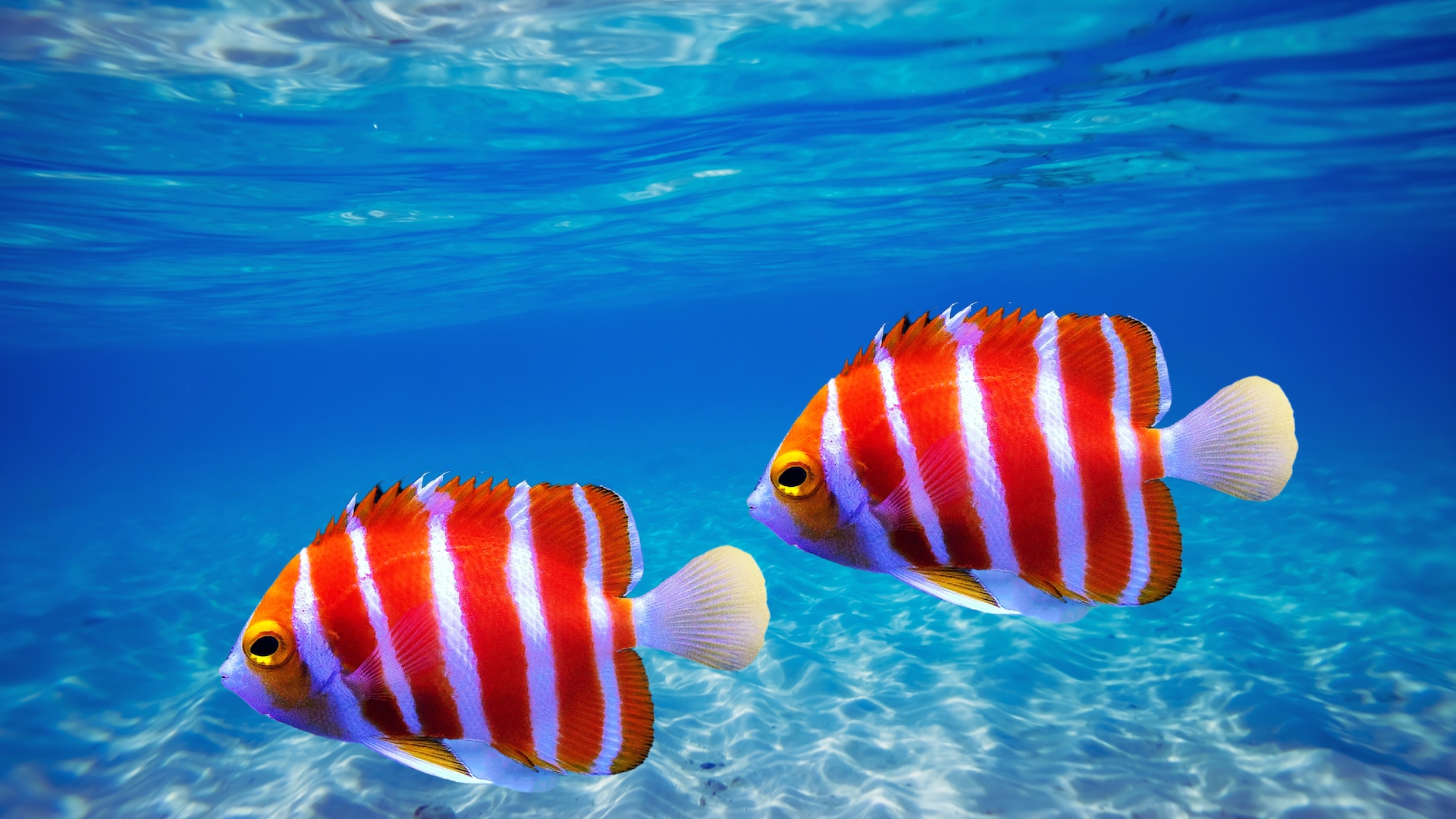
These delightful little angelfish are highly prized as aquarium fish, with an exorbitant price tag beyond the realms of most aquarists. A single fish has sold for $30,000. Found in the wild at significant depths so requires decompression treatment to transition to the surface.
Scientific name: centropyge boylei.
Maximum length: 2.8 inches
Wild habitat: East Pacific.
23. Sleeper banded goby
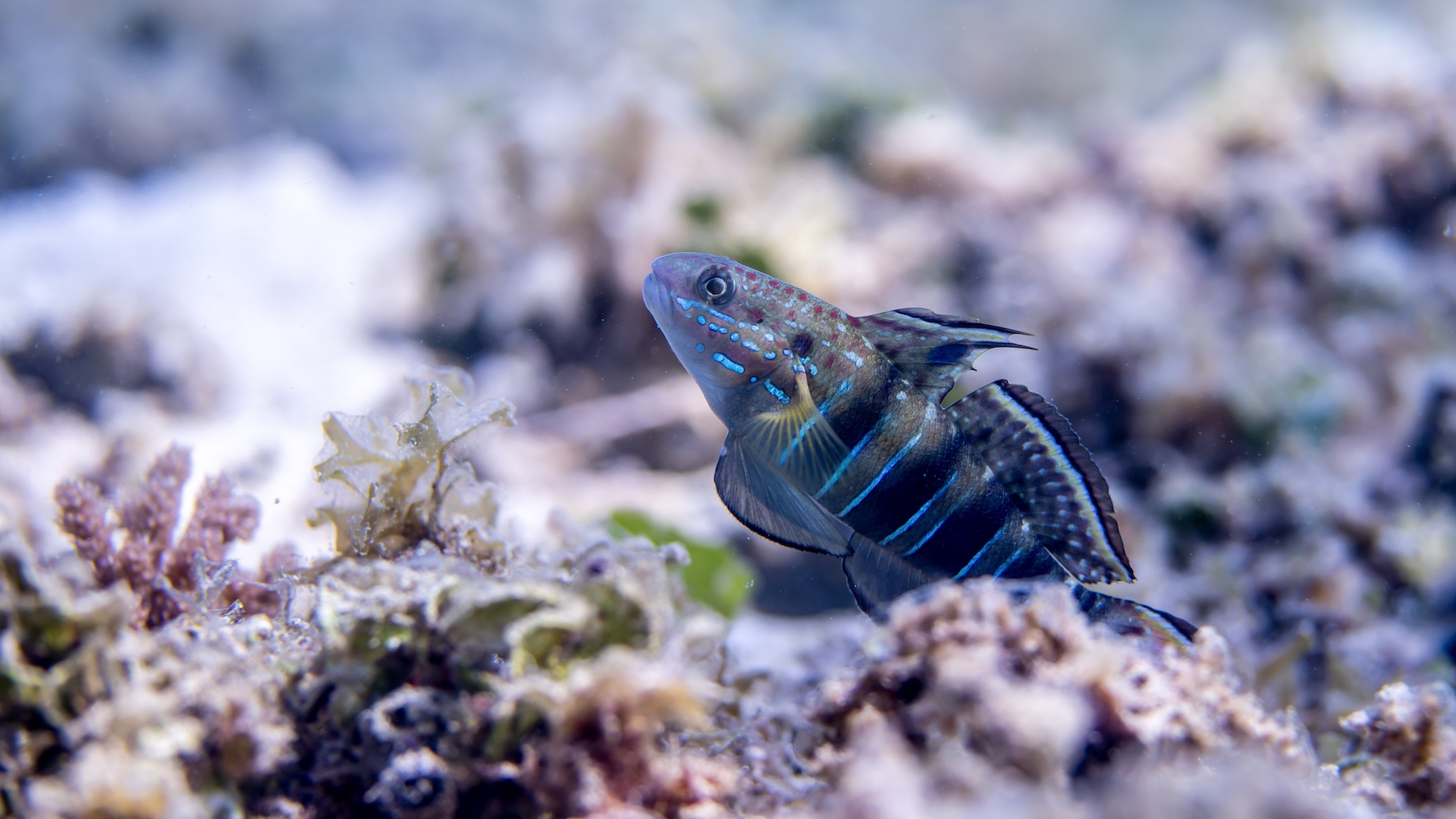
A sand-sifting goby cleans the substrate through its gills, including getting rid of certain bacteria, and also grazes on algae. A peaceful fish that should be kept alongside similarly non-aggressive tank mates.
Also known as white-spotted goby, brown-barred goby, bullet goby; scientific name amblygobius phalaena.
Maximum length: 5.9 inches
Wild habitat: East Indian Ocean, Australia, Indonesia, East Pacific, Central/West Pacific.
24. Kole tang
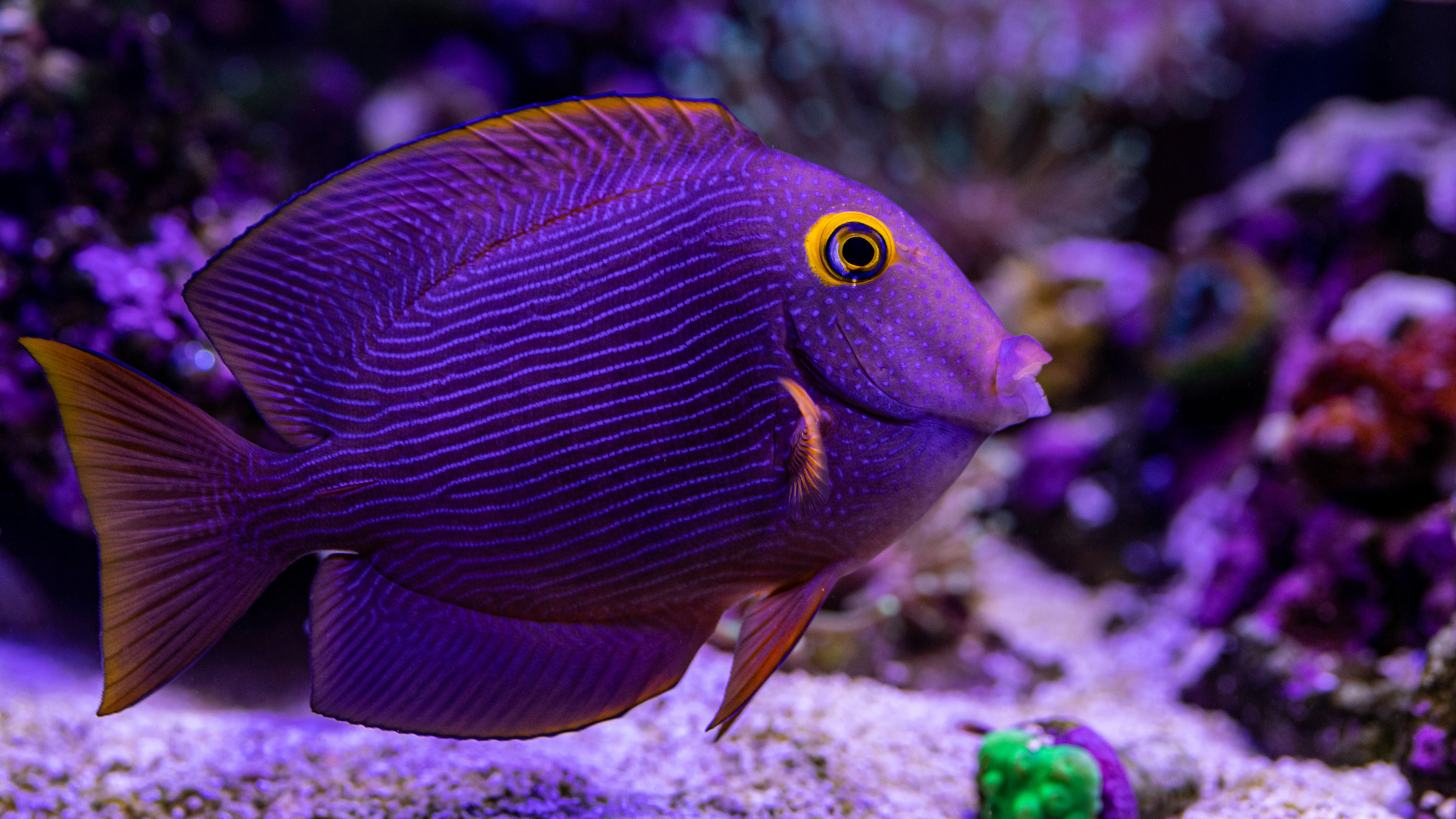
An algae eater with funky looks and specialized bristle-like teeth for grazing on rocks. They have a gold band around their eyes. Also known as spotted surgeonfish, yellow-eyed surgeonfish, and goldring surgeonfish; scientific name ctenochaetus strigosus.
Maximum length: 5.5 inches
Wild habitat: Endemic to Hawaii, also Australia, Indonesia, East Pacific, and Central/West Pacific.
25. Flame hawkfish
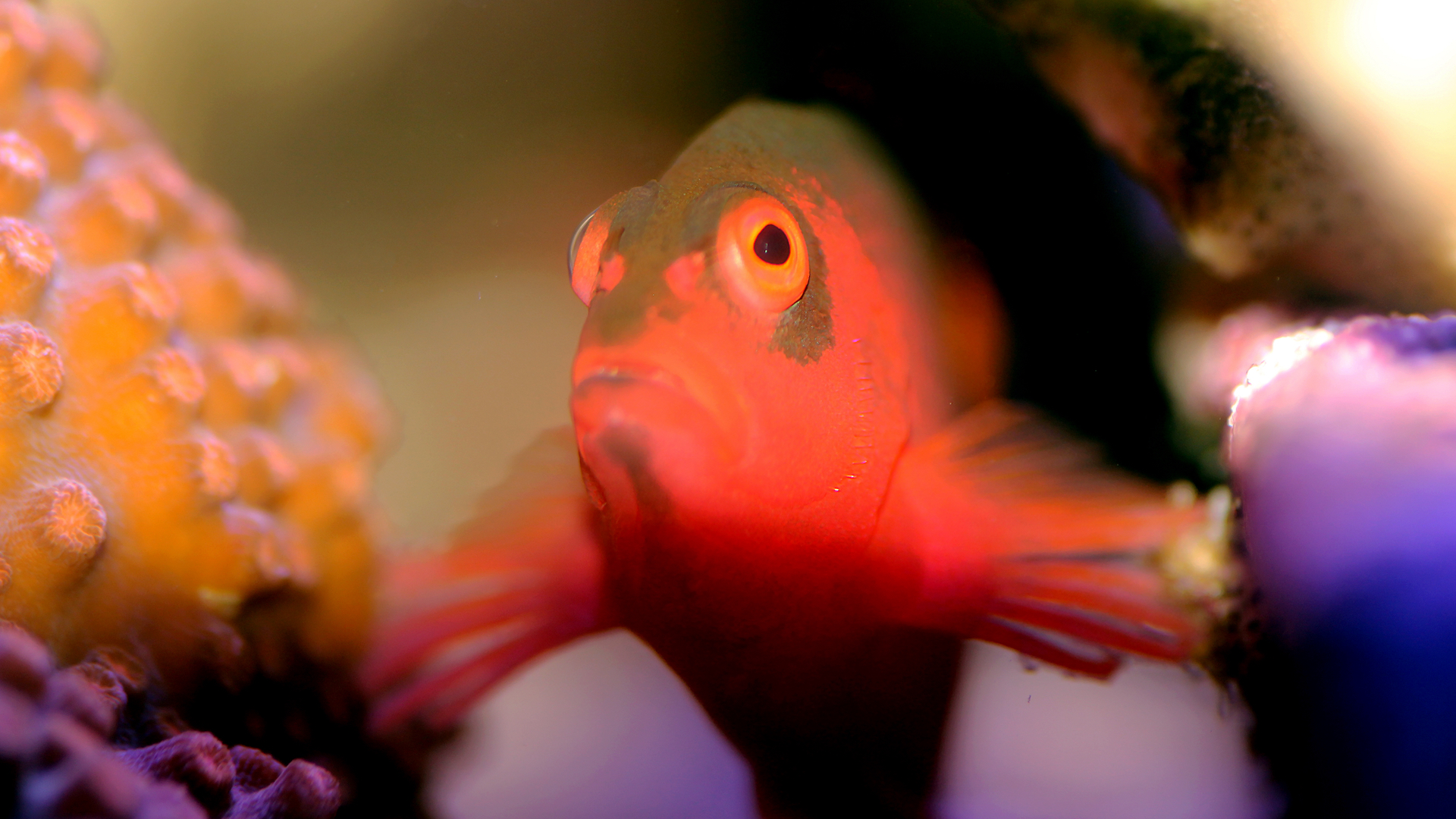
A striking red fish with a black dorsal stripe, these fun characters have a goofy look with their bug eyes able to move independently of each other. Not mad keen on swimming, preferring to hang out on rocks and coral.
Scientific name neocirrhites armatus.
Maximum length: 3.5 inches
Wild habitat: Australia, Indonesia, East Pacific, Central/West Pacific.
26. Volitan lionfish
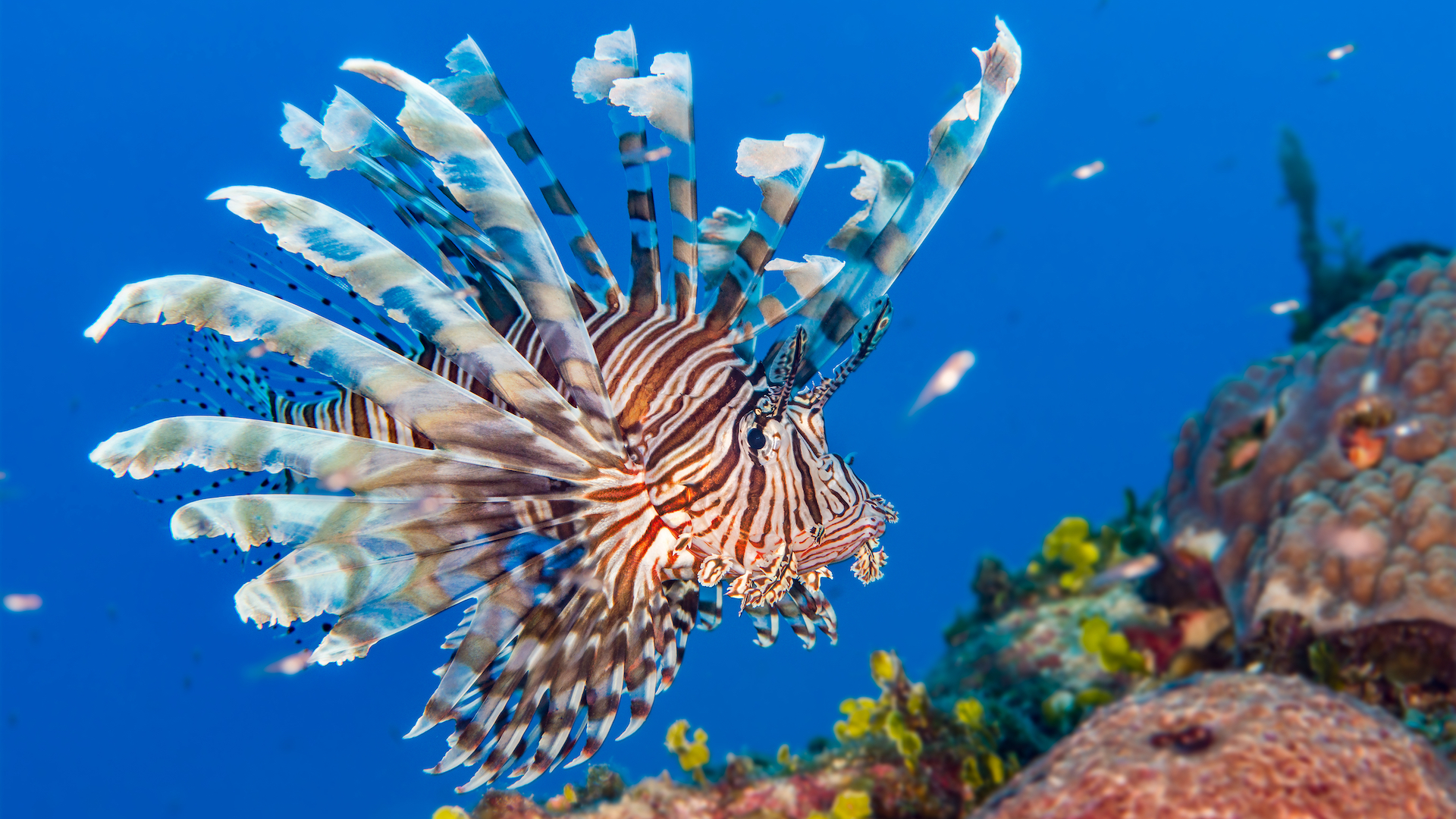
These frilly fish are peaceful in character but highly venomous – the toxins from their spines are similar to a bee sting, but much stronger and can be fatal. Big, athletic swimmers who require plenty of space to move around. Despite their poisonous spines, they are a friendly species that can learn to recognize their handlers.
Also known as butterfly cod, turkey fish; scientific name pterois volitans.
Maximum length: 15 inches
Wild habitat: Australia, Japan, Indonesia.
27. Blue tang
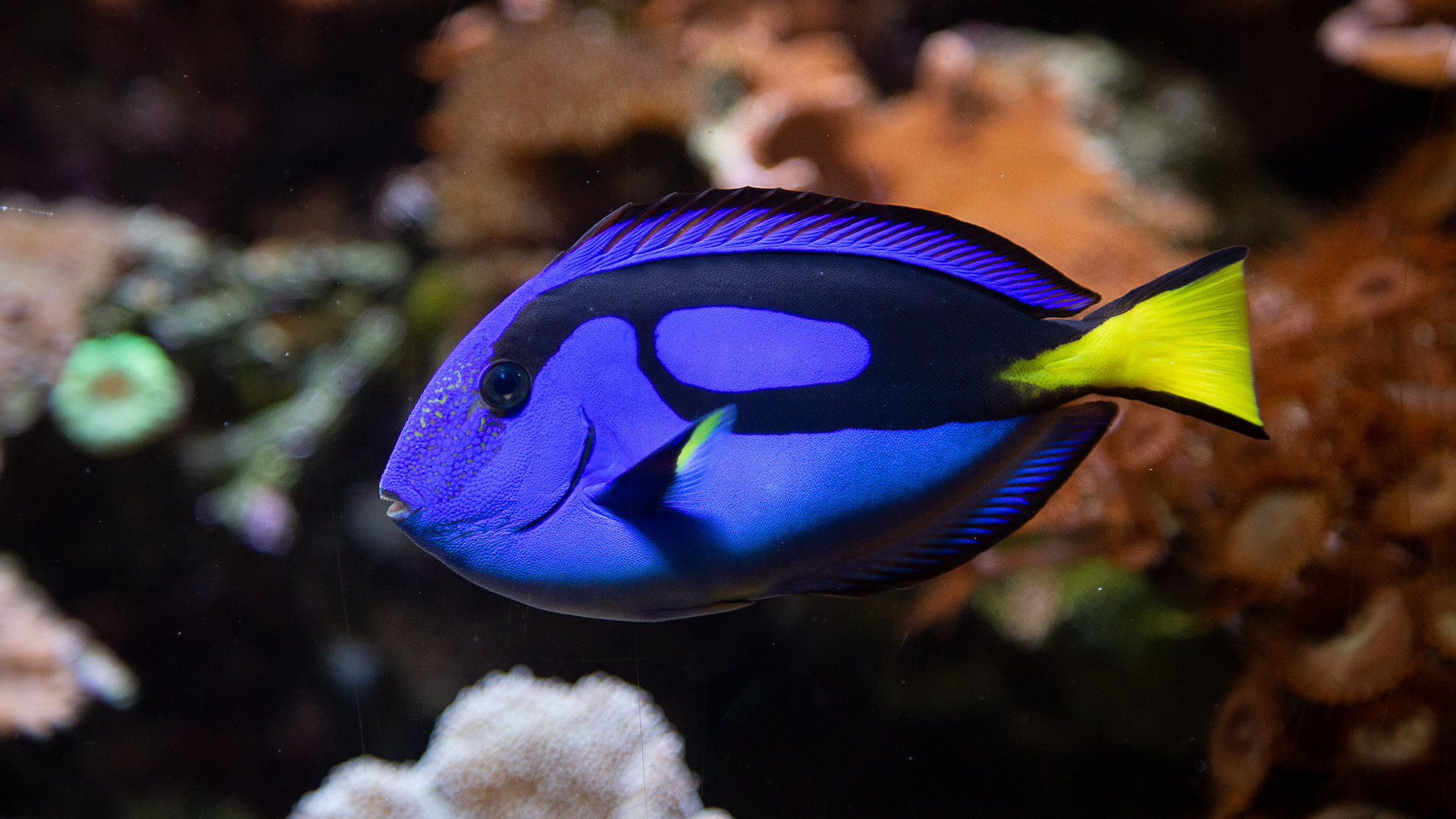
A fairly large marine fish for the aquarium with a royal blue body, yellow tail, and black palette design on their body.
A star on the silver screen, as Dory in the Disney/Pixar movie Finding Nemo.
Also known as palette surgeonfish, regal tang, indo-pacific bluetang; scientific name paracanthurus hepatus.
Maximum length: 12.2 inches
Wild habitat: throughout the Indo-Pacific.
28. Gem tang
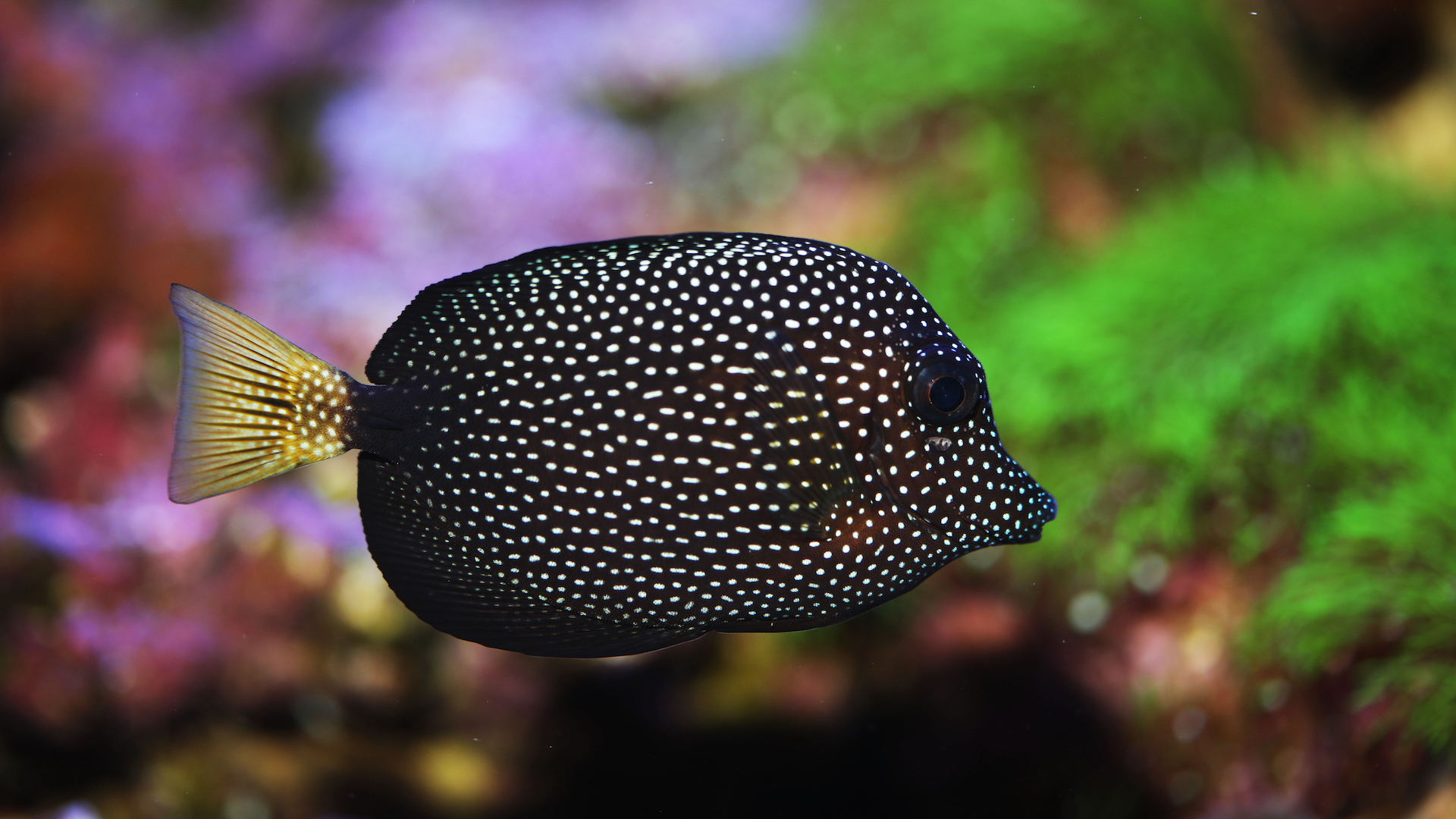
This exotically marked fish is one of the most expensive to buy as a prized specimen – up to $3,000 – though they are fairly hardy and adapt well to aquarium life. Can be aggressive to other tangs.
Also known as spotted tang, jeweled tang, Mauritian tang; scientific name zebrasoma gemmatum.
Maximum length: 8.7 inches
Wild habitat: East Indian Ocean, West Indian Ocean,.
29. Ornate wrasse
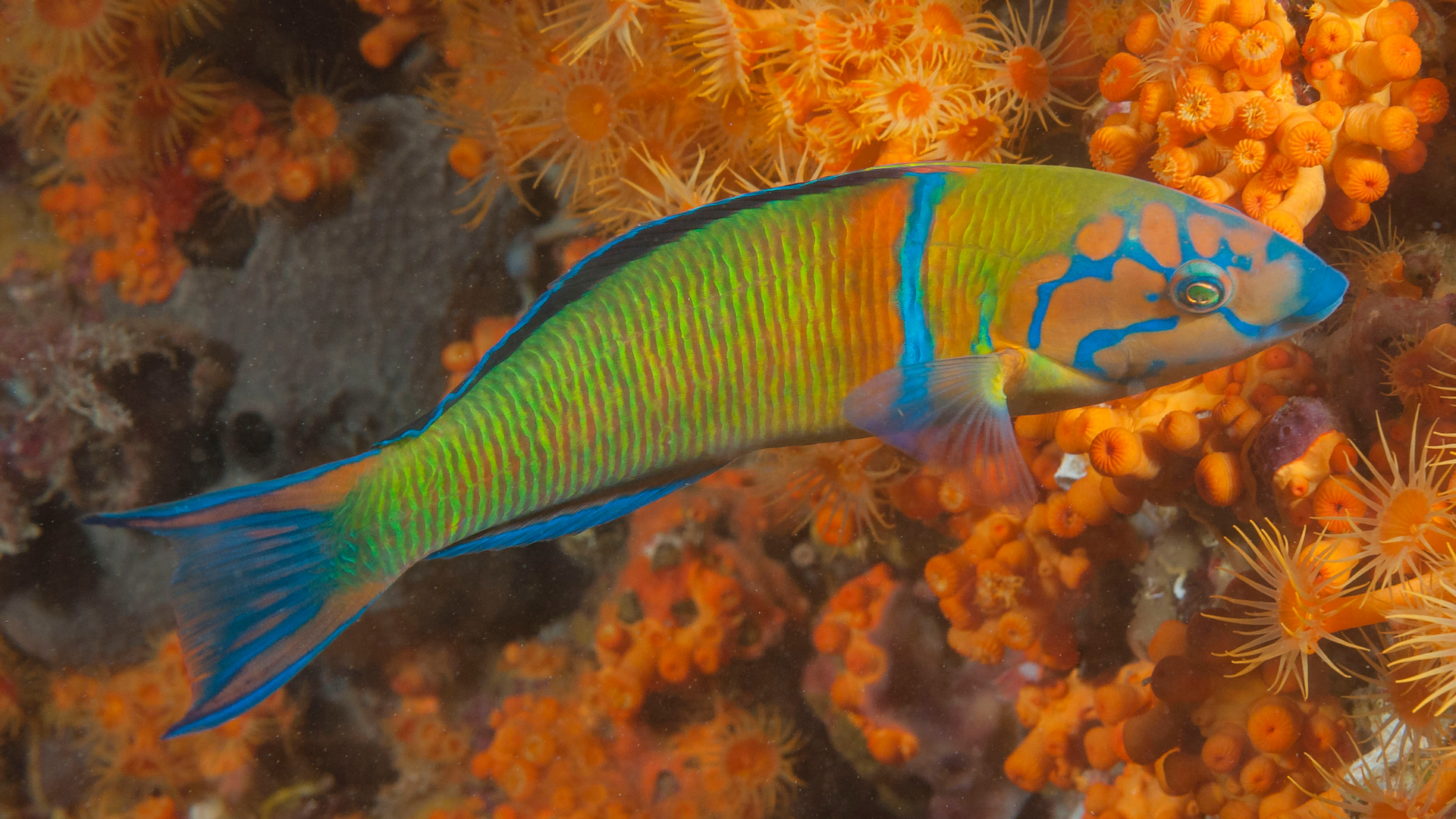
A stunner for a large aquarium, with its distinctive iridescent markings, though the females and males vary, from blood red with green swirls to metallic green with turquoise, and red faces. They are also called the Christmas wrasse, though whether this is due to their green and red markings or their origins around Christmas Island is debatable.
Also known as Christmas wrasse, pinkface wrasse; scientific name thalassoma pavo.
Maximum length: 9.8 inches
Wild habitat: Mediterranean Sea, West Indian Ocean.
30. Japanese angelfish
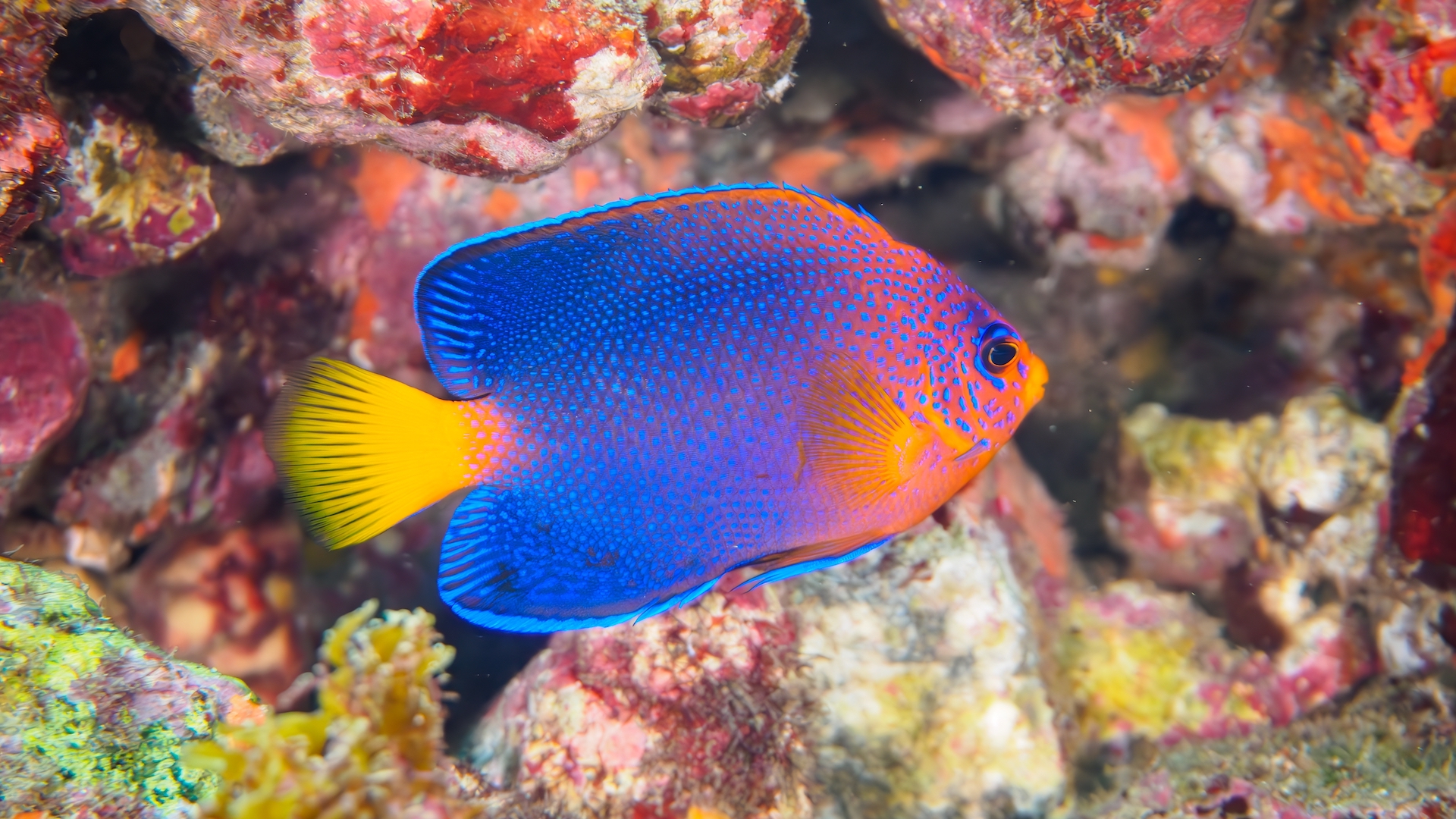
A rare dwarf angelfish, with a fabulously exotic appearance. Their sunset-colored body turns a deep blue/purple body towards the tail and is marked with electric blue spots, with a yellow caudal fin. A crown jewel in any aquarium, with a price tag to match.
Also known as Japanese pygmy angelfish; the scientific name centroypyge interruptus.
Maximum length: 5.9 inches
Wild habitat: Japan, Hawaii, Taiwan.
31. Yellow tang
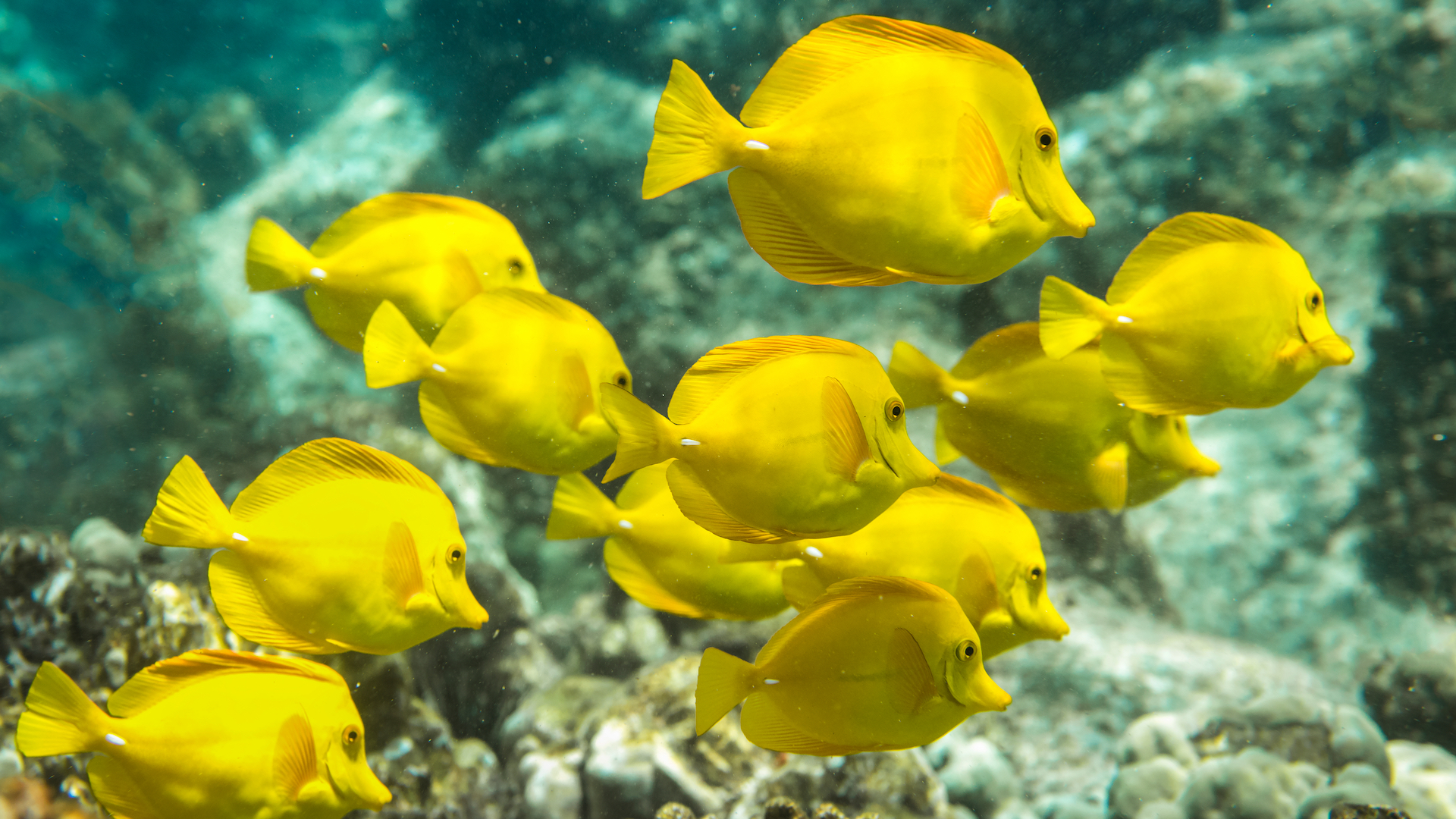
A vibrant and eye-catching fish with a graceful, active swimming motion, this is a popular resident of many a marine aquarium. Their peak spawning happens around a full moon. Also known as lemon sailfin, somber surgeonfish; scientific name zebrasoma flavescens.
Maximum length: 7.9 inches
Wild habitat: Central/West Pacific.
32. Pink spot goby
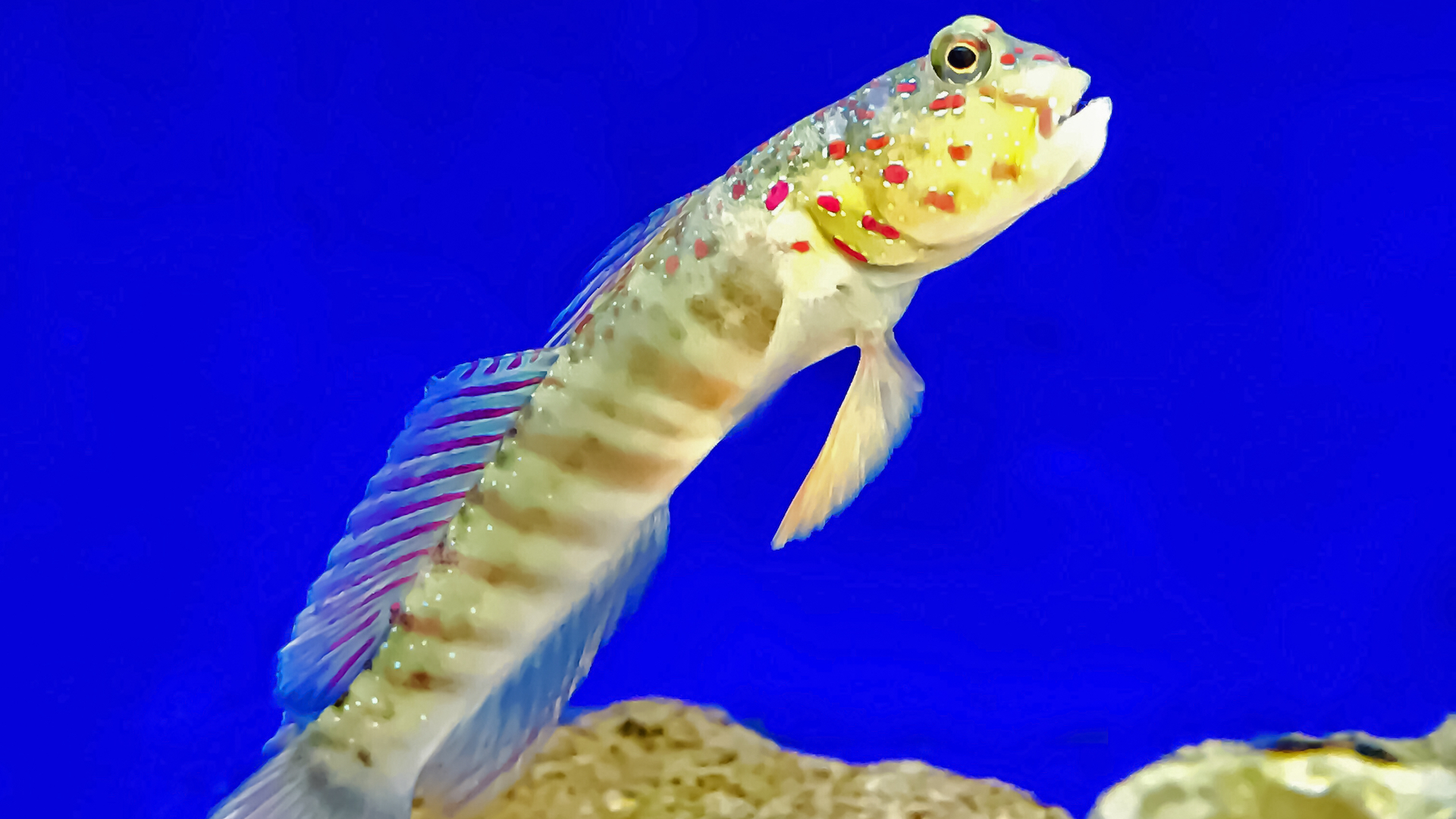
A burrowing goby that loves to dig holes in a sandy substrate. They form a symbiotic relationship with the alpheid shrimp and hang out in the safety of their burrows together (with the goby keeping watch). Watch out, these gobies love to jump!
Also known as pink speckled shrimp goby; scientific name cryptocentrus leptocephalus.
Maximum length: 4.7 inches
Wild habitat: Australia, Japan, Indonesia, East Pacific, Central/West Pacific.
Martha is an experienced journalist working in both print and digital media. She specializes in the canine, equine and rural sphere where she has covered a wide range of topics from cloning animals and the ingredients for a perfect yard dog, to helping owners find the best canine GPS trackers on the market. When she’s not busy writing about dogs and horses, she’ll be found either aboard a horse or looking after the menagerie of pets in her care.
